#also ALSO i did this in a similar style to my solar piece from earlier in the year!
Explore tagged Tumblr posts
Text



Hwasa - NA (digital drawing) ~
(09/2024)
absolutely loveee her latest solo release, and this is especially dedicated to the song 'road'!
#artists on tumblr#digital art#kpop fanart#hwasa#hwasa fanart#hwasa na#mamamoo#mamamoo fanart#ahn hyejin#it's been so long since i drew her i had a real struggle w/ her face pfft#hopefully it still looks like her though!#also idk how to tag the album cos i'm unsure if it's O or 0 lol... i think it's O???#also ALSO i did this in a similar style to my solar piece from earlier in the year!
12 notes
·
View notes
Text
The 6 Best Trip Planning Apps for Headache Free Travel – Review Geek
Your notice about search engine optimization can also be good, nevertheless, I do suppose that if a weblog stays at the top for a very long time, it is also about high quality and fewer about SEO. Thanks for taking the time and writing such a considerate comment. Research indeed is the important thing however some instant journey plans are tremendous enjoyable. And finding the right travel company is a little headache however i feel it is needed. particularly if you want to journey in a different country where you nearly know nothing.
Who has the best all inclusive vacation packages?
The most common reason why people go all inclusive is the value for money; with food, drinks and snacks catered for, it can be a great way of making your holiday more affordable.
The signature Hard Rock rocker vibe may be seen throughout the resort, whether it's in the music-themed decor or the free guitar leases. On-site amenities corresponding to golf, an arcade middle, and a sprawling health heart assist hold visitors busy. Aruba’s drier local weather and southern location within the Caribbean additionally signifies that it’s rarely hit with hurricanes. In reality, on the time of writing, the last glancing blow was by weak Hurricane Felix back in 2007.
This can also be a good time to go to London and Paris and Central Europe. Barcelona needs no less than two days of your time to see the most effective of it. There are additionally nice day journeys you'll be able to take from Barcelona, corresponding to visiting Montserrat, Girona, Costa Brava, and Tarragona. Florence deserves the largest chunk of time in this itinerary.
Thank you for offering such descriptive and well-elaborated ideas. I would definitely maintain them in mind while planning a trip for me now. You can e-book your hostel with Hostelworld as they have the most complete inventory. If you want to keep elsewhere, use Booking.com as they consistently return the most cost effective charges for guesthouses and low-cost hotels. To assist you determine one of the best plan for you and your journey, right here’s my final guide to picking a good insurance firm.
What are the do's and don'ts of itinerary preparation?
Travel Agent Do Not Cost More - Vacationkids never charges services fees. Our services are free to our customers. If their parents want to use miles too book their flights or if there are cheaper rates online, Online Travel companies do charge service fees. They build them into the cost that you pay.
In the publication, UN areas and subregions are ranked by the variety of worldwide customer arrivals, by the income generated by inbound tourism, and by the expenditures of outbound travelers. With a dramatic cliffside setting in Negril, this adults-solely all-inclusive is taken into account certainly one of Jamaica’s most particular resorts — albeit one with high nightly rates. Meals and drinks are included, however the choices right here go above and past typical all-inclusive fare.
Most people need several days in a place where they couldn’t see a museum or take a tour even when they wanted to. A stop within the mountains or on an island, in a pleasant rural city, or at the home of a relative is an effective way to revitalize your vacationer spirit. If you’re passionate about Renaissance art, Florence is a must. England’s Cotswolds beckon to those who fantasize about thatched cottages, time-handed villages, and sheep lazing on inexperienced hillsides. For World War II buffs, there’s no more stirring experience than a go to to Normandy.
We will be arriving in Munich after which plan to cover Czech Republic, Austria, Italy, Switzerland, Paris and spend final four-days in London since our return flight is from London. Plus, it’s not just the most affordable cities in Europe. Malta, as an Island, could be comparatively cheap too.
This “General MacArthur” method is a key to touristic happiness.
,” Ed Perkins writes, “An agent is an enormous help if you value your time.
Not positive concerning the place, however either of Spain, UK or Sweden.
Log into any airways' web site a couple of days earlier than your tip and you'll be able to find all of this info.
If you’re feeling nervous, don’t fear — that’s perfectly regular. You’re about to embark on a tremendous journey — and that’s a huge change.
Reading this makes me realise how much planning I don’t do before reserving a trip! You’ve given me some great tips, and plenty to think about before reserving my subsequent travels. I never use a journey agent but I’d take into consideration attempting it out. By the time I get to this a part of planning my holiday, I know that many of the work is done. Now, it's about specializing in the smaller details.
Most travel brokers are paid a fee from resorts, airlines or tour operators after they guide a shopper with them. Some resorts or tour operators pay more fee than others.
Passport photographs will value you about an extra $10, or you possibly can print your own free of charge at ePassportPhoto. Europe has an insane quantity of fine beer and wine — so you should sample all you possibly can.
It lays out every piece of knowledge you may need on your trip so you're by no means left hunting round on the lookout for an tackle or a cellphone quantity. This means you'll be able to spend extra time exploring or enjoyable and fewer time making an attempt to prepare yourself. Do your research about vacation spot prices primarily based in your type of traveling. This goes to help you determine your daily bills and provide you with a every day budget on your trip.
Spend a minimum of one day exploring Florence, after which use your additional days to take day trips into Tuscany, visiting Siena and the other hill towns. You can do this on your own by renting a car or using the public buses (however this was a nightmare in our expertise…we highly recommend renting your own automotive or hiring a driver while in Tuscany!). Ten days is simply sufficient time to get a style of this country.
BARCELONA, SPAIN Travel Costs
There are miles of white-sand seashores (like Rendezvous Bay, overlooking neighboring Saint Martin island), as well as secluded coves reached by boat, similar to at Little Bay. After a day within the solar, hit up nice restaurants, as well as a low-key nightlife with stay music that spans from reggae to string bands. In a nutshell, you have fewer things to fret about with all-inclusive packages.
If you worry about issues that are just out of attain, you gained’t respect what’s in your hand. I’ve taken dozens of European journeys, and I still want more time. It’s a blessing that we can by no means see all of Europe. Alternate intense big cities with villages and countryside.
But in case you are planning on having three drinks or extra per day, plus three meals a day, it might average about $one hundred a day, according to her calculations. Jen Pellerito, journey writer and creator of Jen on the Run, did an analysis using an Expedia seek for resorts in Cancun for seven days (Aug. 24 to Aug. 31, 2018). Many all-inclusive resorts are close to major airports and big cities, stated Ebert. If you’re visiting a spot like the Caribbean, you’ll discover many resorts have private access to the beach. For instance, when you’re traveling alone, traversing a huge space, and spending the vast majority of your time in huge cities, it makes more sense to go by prepare with a rail cross than to mess with a car.
1 note
·
View note
Text
My midcentury modern renovation
After buying myself a duplex in Perth built in 1979, I decided it needed renovation. Little had been done to the house since it was first built so it was looking very tired and starting to collapse in places. Building oversite was obviously not strict at this time as many roof beams were not nailed in place properly and the weight of the concrete tiles was collapsing the roof in the lounge area. This also resulted in the eaves dropping, allowing water to seep into these areas. The glue holding up the ceiling in many of the rooms was also failing and many of the ceilings were collapsing. As such, these were the initial works I had engaged workmen to undertake. After these works were completed the roof was painted a very pale orange colour to reflect the sunlight and reduce the heat entering the roof space and solar panels were added to reduce my power bills.
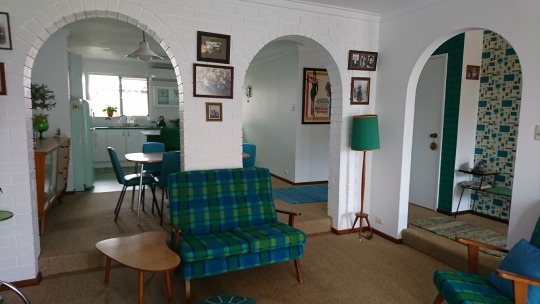
Then it was time to start renovating the inside. The lounge had a large window that overlooked the front garden which was beginning to leak so the first thing I did was replace it with wooden French doors. These open out onto a newly paved patio area with a patio built from the wood used in an old carport that someone advertised on Gumtree. The kitchen and dining room were dark brown brick walls with four arches. As arches were a feature of the retro era, I decided to keep three of these in the lounge/dining room wall so set about painting them with two coats of undercoat and two of a semi-gloss white paint. The bricks all had to be dusted first as they contained 30 years of dust and the whole job took me at least 2 weeks. But it was worth all the work as they now provide a clean-looking, textured wall for this space.
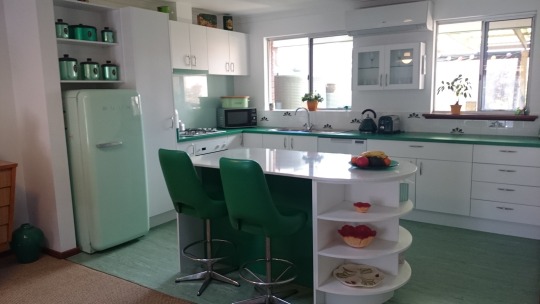
Next, I had to decide how I was going to renovate my kitchen. This small area was walled off with dark brown bricks on two sides and a small archway to communicate between the kitchen and dining room. This limited my ability to interact with guests while I was cooking. After much deliberation I finally chose to knock down both these brick walls, virtually gutting the whole kitchen area. Next came the exciting task of designing my new kitchen. Two large windows and an air conditioner remained on the far wall so I had to include these in my design. I had purchased green kitchen appliances to match a retro fridge I had bought at a second-hand shop a few years earlier so knew what colours I wanted, which is a big help when doing any renovation. The fridge had also influenced my decision to have a retro design for my house. After hours researching retro kitchens, I also knew the features I wanted including: drawers with cupboards underneath, a row of drawers and open, circular shelves at the end of the cupboards. I also wanted a small cupboard with glass doors on the wall, an island and a floor to ceiling pantry.

I had already collected some Jason green kitchen cannisters for flour, sugar etc so knew I wanted some shelves to display these. Fortunately, my small-sized fridge allowed room for these shelves to be placed above it. I did a lot of research on-line until I found the right shade of green Laminex Laminate for the benchtop. Simon, at the kitchen renovation company I engaged to do the work, was a great help in deciding what was possible and what materials I could use. I wanted a matt finish so used a white Melamine Sheen for my doors and panels and found some retro-looking handles to place on them. I knew I needed as much white as possible with the dark green benchtop and chairs so decided a white stone benchtop would look best on the island. I found a lovely white stone with a greyish-green fleck in it at the kitchen company which was just what I wanted.
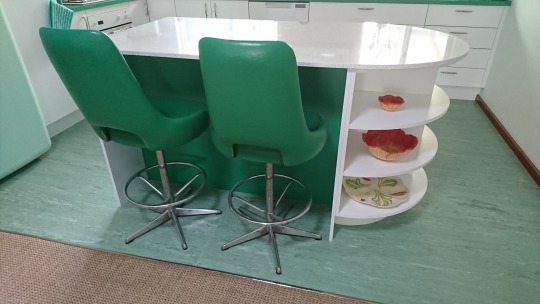
After the walls had been demolished my kitchen cabinets arrived and after looking at them, I realised the white was overwhelming and needed breaking up. To do this I asked for a small strip of green Laminex to be placed on the front of the exhaust fan and a larger piece to be placed on the back of the island where the green chairs would sit. This made a big difference to the overall look of the kitchen as it helped to balance the colours and I’m really pleased I did this. After the kitchen had been installed, I then had to decide what tiles would be placed above the benchtop and what I would use for the splashback.

I had visited a small shop in Fremantle that sells hand-made tiles of vintage design so researched their website and found some lovely tiles with a green art-deco design. Having only these tiles would have made the small area look too busy so I decided to scatter a few amongst some white tiles the same size. They were also very expensive so with this design I was able to do the tiling for a more reasonable cost. I tossed up whether to get a lovely picture on the splashback but decided in the end to get a plain colour as I didn’t want it to dominate the kitchen. I decided on a silvery-white look and did a bit of research trying to find something that would give me the look I wanted. In the end I went to a company that designs and sells splashbacks and found one that had a slight silvery sheen to it but it also had a greenish tinge to the glass. When it was installed the green was even more pronounced and it came out looking great with the green benchtop.
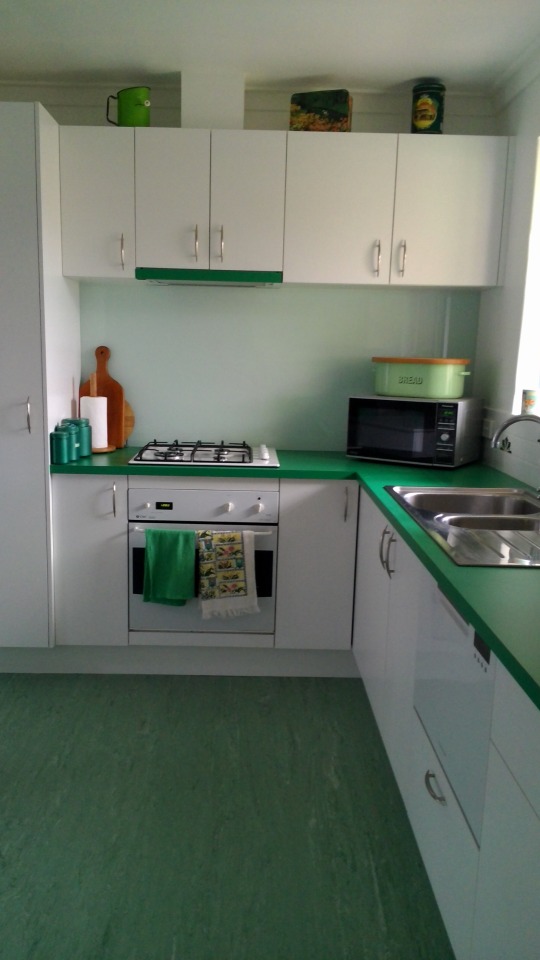
Next, I needed to do the floor. I also wanted to replace the carpet in the dining room, lounge and passage and during my research found a company selling natural fibres which I liked the idea of. These are mostly made of jute, coir, sisal, wool sisal mixes and seagrass. I felt these carpets were more environmentally friendly and thought they might be less attractive to dust mites. After much deliberation I finally found one made of sisal I liked and had this installed. Then I needed to find a lino or tiles for the kitchen that would match the colours and retro look I had designed. I wanted green and white tiles but could not find them anywhere. My research led me to commercial linos and I found one in green that I liked. However, when I ordered it, I was told they had stopped making that design and I was provided with some other samples to choose from. The one I chose has actually turned out to be one of the best decisions I have made for the design of the kitchen. It is exactly the right colour and the pattern is also similar to that found in some older houses. Perhaps some things are meant to be….
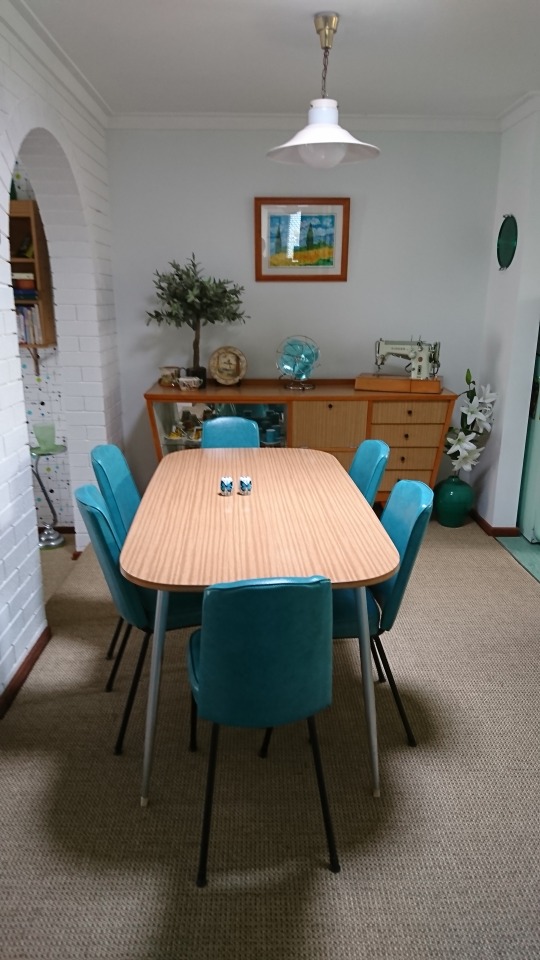
I had been buying second-hand furniture advertised on my local Gumtree website for years as I didn’t have much furniture when I shifted into the house and I like the retro style of furniture. Someone had sold me her grandmother’s sideboard which was lined with a blonde-wood Formica. A year or two after this I found a lovely dining suite in the same Formica style with 6 turquoise chairs that matched the colours in my lounge. This completed my dining area nicely.
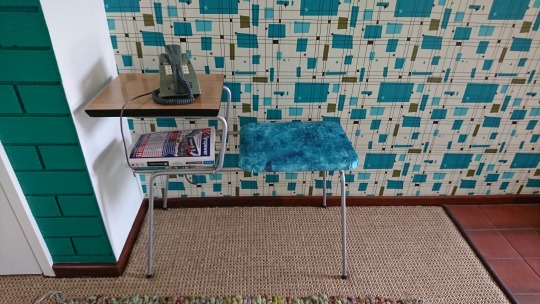
While I was waiting for my kitchen to be installed, I spent lots of time plastering, sanding and painting the walls in the lounge, foyer and kitchen area as these had had a lot of hard wear over the 30-odd years they had been painted. I mixed my own paint so I could get different shades in each room of the house. I wanted very light shades of blue and green which meant a lot of trial and error. (This ended with me having to sell a whole 4L tin of paint for $20 I had tinted but couldn’t use because it was too bright). I then decided to wallpaper the foyer wall. This wall consisted of a few pieces of gib-board that had been placed onto the wall and poorly joined. As a result, I had to do a lot of plastering and sanding. Then I bought lining paper and with the help of a friend, we placed the paper vertically across the wall to help cover the joins. I found that an English website, Spoonflower had by far the best wallpaper designs and after a lot of searching I found a retro, atomic design with the right colours I wanted. I had wallpapered a house before when I lived in New Zealand so had a fair idea what I was doing. I also found the new wallpapers with glue on the back are very easy to slide into place. The design on the wallpaper also helps to match each strip.
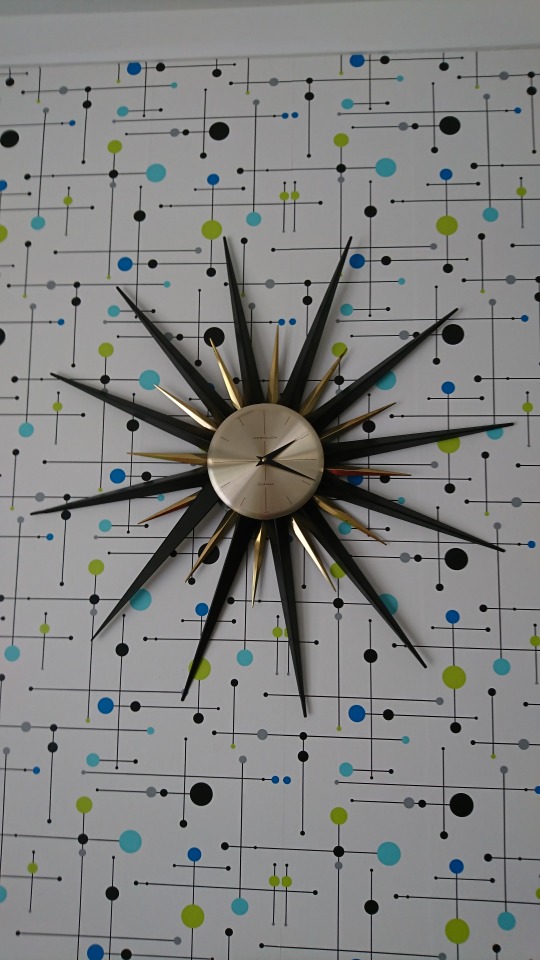
I was so happy with the look of the foyer wall that I decided to put wallpaper on one of the walls in the lounge room. I needed a wallpaper for this wall that wasn’t too bold or bright so that it didn’t conflict with the tartan in my lounge suite and that had an atomic look to it. Another extensive search on Spoonflower ended with me finding a new design that really suited the colours in my lounge suite – green, turquoise and blue.
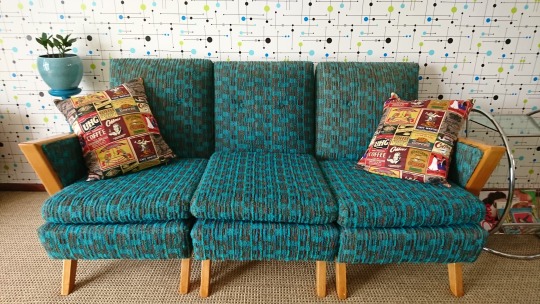
It is interesting how sometimes things just fall into place. Not long after completing the wallpapering of the lounge wall I noticed an advert for a second-hand lounge suite in exactly the right colour – turquoise - that was in the atomic style. I was able to buy this and renovate the wooden parts of it. The upholstery is a little faded in places but it is in reasonable condition for the age of the lounge suite so I didn’t have to spend much on it and it is perfectly suited to the wallpaper on the wall. It was also a plain colour which worked in well with the other tartan lounge suite I had already purchased a few years before.
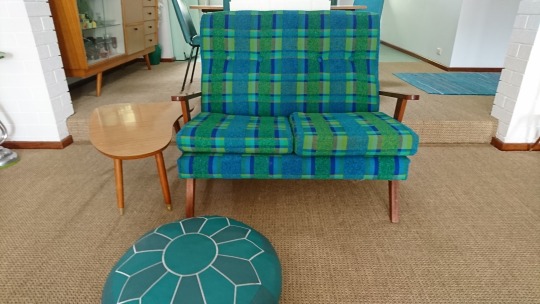
An art-deco style piano, an old stereogram that works and a retro-style coffee table make up the other furniture in this room.
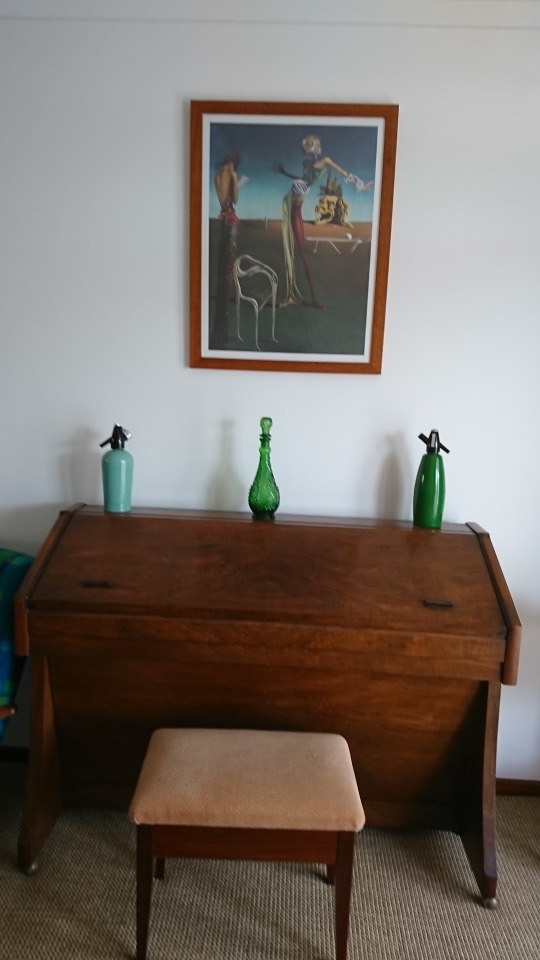
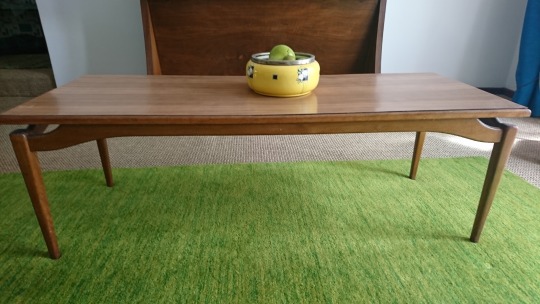
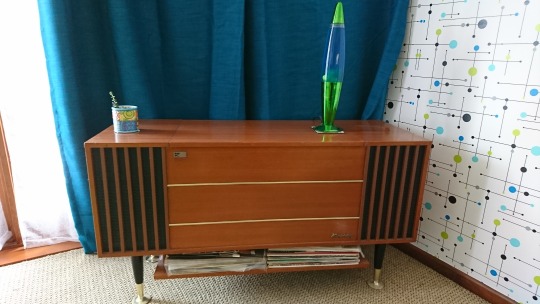
I have also purchased other collectables on Gumtree or second-hand shops that help to enhance the retro look of the lounge room. Bright teal curtains and a green mat have finished off this room nicely. My last job is to renovate the coffee table top.
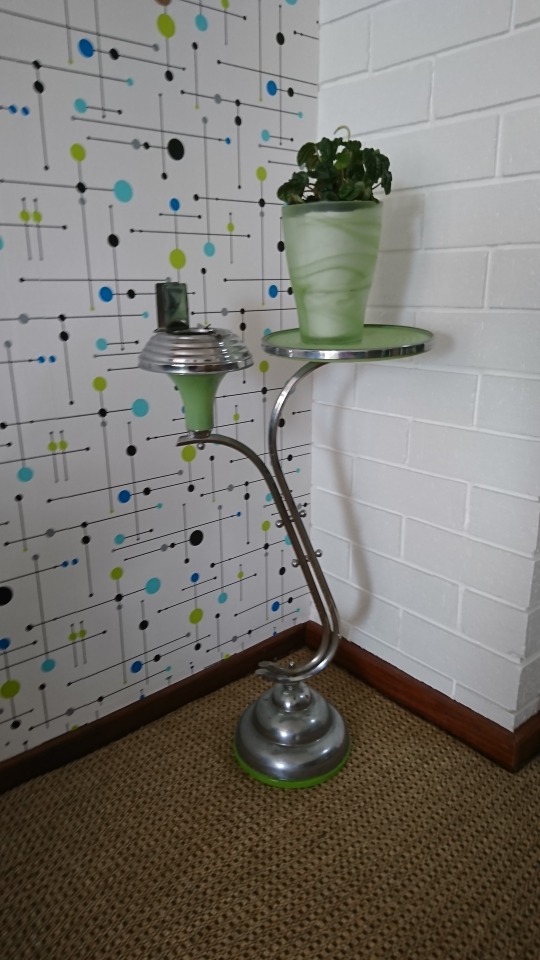
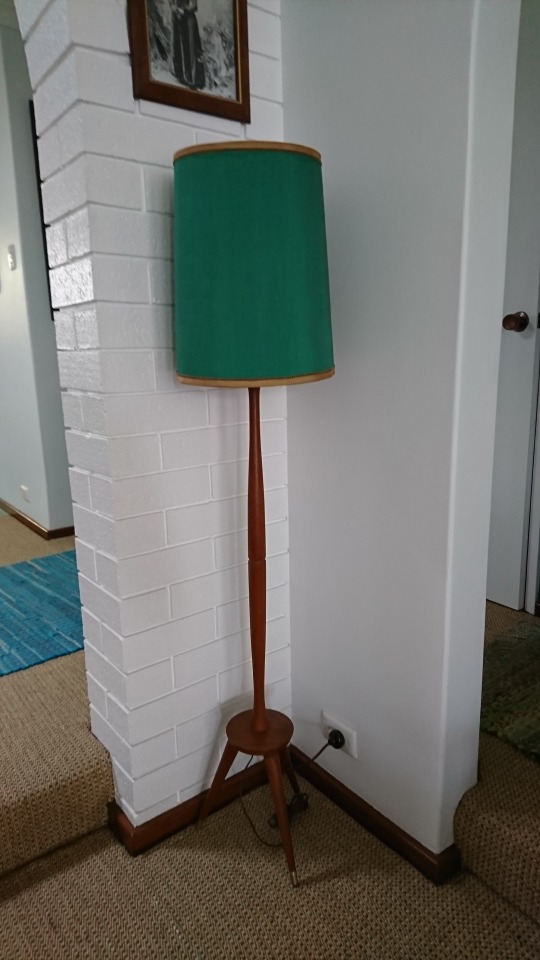
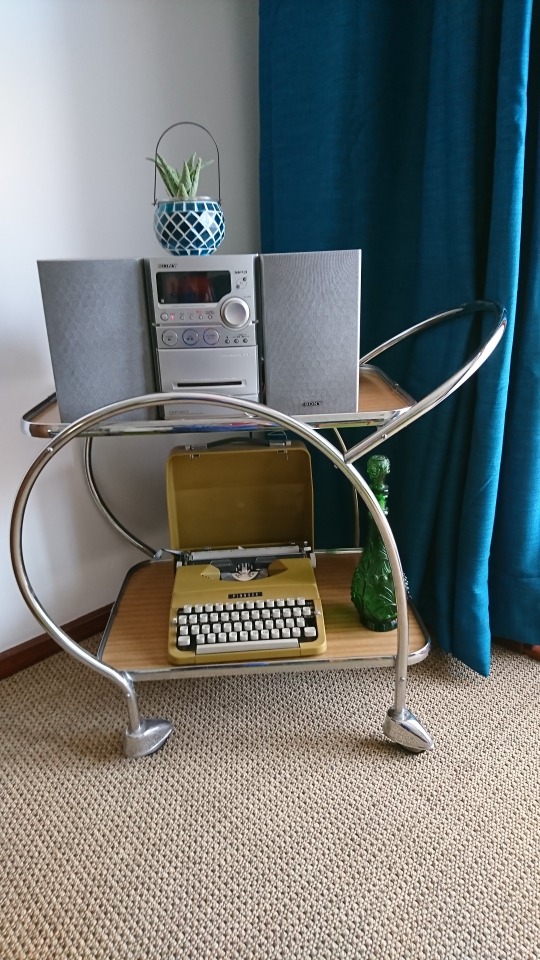
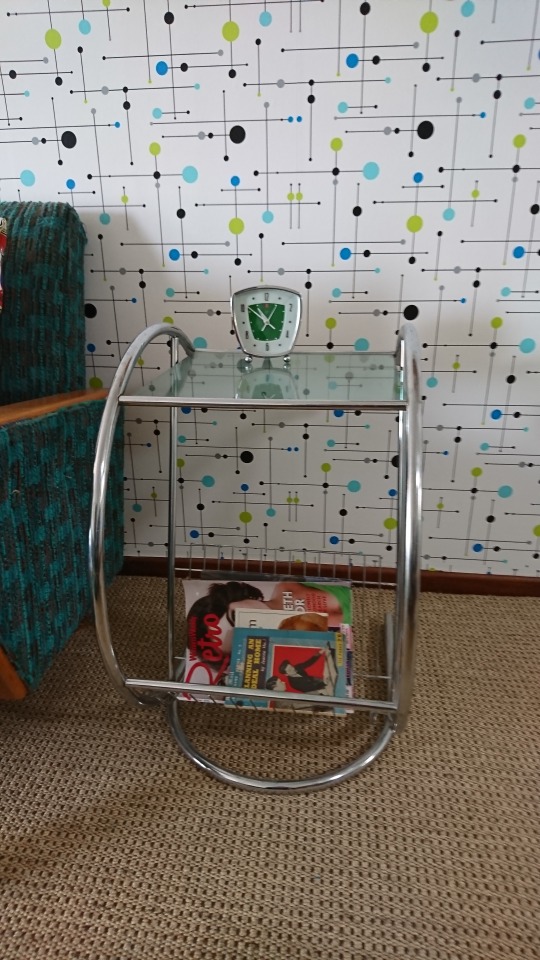
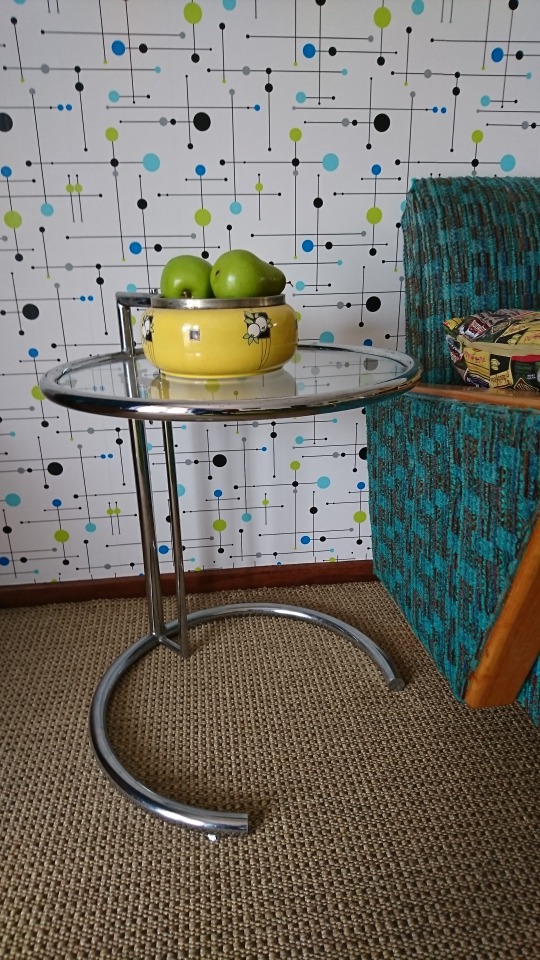
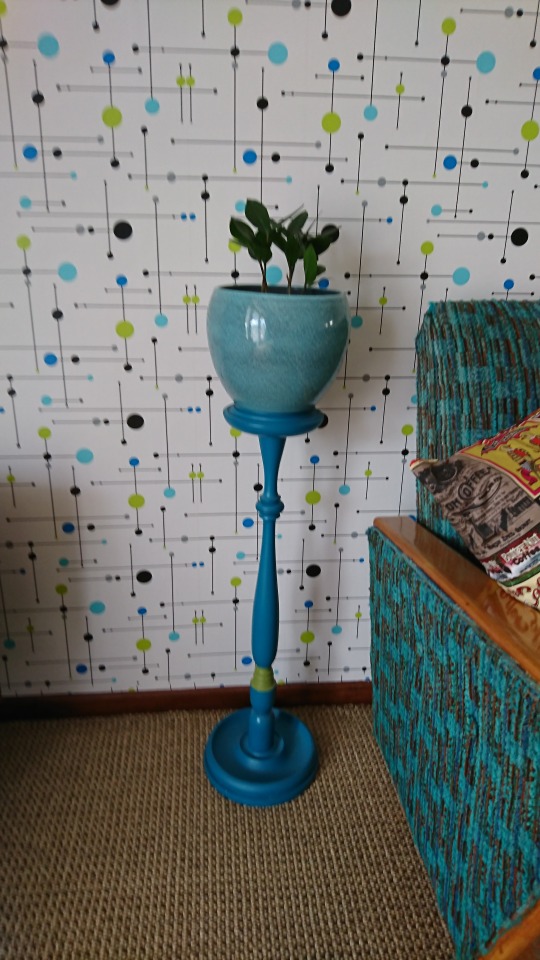
The spare bedroom has also been renovated in a retro style. After fixing up the plaster and painting the walls, then varnishing the windowsill, I proceeded to paint a lovely retro dressing table I had acquired off Gumtree. I also found some interesting bedside lights and altered them to hang on the wall above the bed. Lastly, I have bought a brightly coloured new bedspread to brighten up the room. All that’s left to do is to renovate the bedside table.

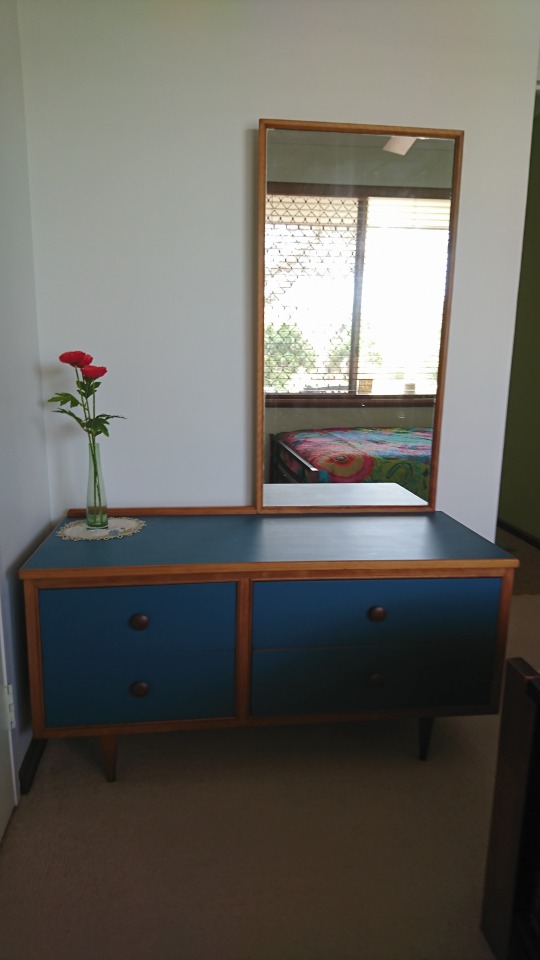
This renovation has taken nearly 2 years with many hours of research and work. But it has been achieved using a modest budget. It has been a labour of love and I’ve really enjoyed the opportunity to use my creative abilities to create a home that I really enjoy living in. I hope it gives somebody some ideas for how they can create a midcentury modern look to their home on a modest budget.
2 notes
·
View notes
Text
Darkiplier in 2017: An In-Depth Look (Part 4)
(Memory a little rusty? Read Part 1, Part 2 and Part 3 before going forward.)
"Well, I've got a news flash for you, brain trust. That's not how it works. You die, and a demon sets up shop in your old house, and it walks, and it talks, and it remembers your life... but it's not you."
- Buffy, Buffy the Vampire Slayer (2x07: "Lie to Me")

So, here it is: the long-awaited final installment of my Darkiplier in 2017 essay.
Remember when I said anything could happen for the remainder of 2017? Well, it basically did. The final quarter of the year brought with it an explosive finale... that is to say, a fascinating origin story.
But we'll get to that in a moment.
Prior to the events of October and following in the wake of the Darkiplier vs. Antisepticeye vid, we were given quite a few bits, bobs and teasers of the horror to come.
In the second Try Not to Smile Challenge, our favourite Youtuber remarked that "I've turned my heart into a stone-cold ice cube of death. All joy has been purged from me in every way possible, and I have no smiles left for anybody." Then he added, with his usual sardonic humour, "It's #smilenever up in this bitch." He promptly spent the remainder of the video looking like he was in agonizing pain from the human experiences he was observing (and intermittently groaning and growling from his frustrated attempts at self-restraint).
A deceptively simple game titled V appeared on Mark's channel in September, and included a seizure warning as a result of its visual style... a style reminiscent of Dark's attention-grabbing, almost painful aura. Chook and Sosig: A Case of Murder is a quirky little diversion that follows a ghost chicken and a noodly-limbed cat as they solve the mysterious death of a popular entertainer (a writer, in this case). Another strange little vid, this time an animation of Mark's Firewatch playthrough, was also released. Though the dialogue is actually taken from a game that had been played a year prior, Forrest Byrnes' lines about death lying in wait and being unable to leave are also oddly fitting.
The artistic black-and-white game I woke up next to you again. contained themes that, upon reflection, are consistent with the overall narrative of Darkiplier's character. Its story is of an attractive, enigmatic stranger (whose appearance is occasionally marred by a subtle glitch effect) seduces you, slowly drains you of your life and ambitions, until you are left an obsessive and hollow husk of yourself. Interpretations vary on what the story of "I woke up..." means (including that it might be a metaphor for drug addiction), but the real meaning is left intentionally vague by the programmer. The being your character is faced with might very well be a soul-devouring demon, for all one knows... especially given that the "girl" in question doesn't appear in the picture you show of her to a friend.
Following the events in early October, Mark joked during his play-through of The Evil Within 2 that the force-feeding mother was "speaking in multiple voices... a clear sign that that might be Darkiplier over there. I think she turned grey when the lighting changed..." (a clear reference to the insanity the fandom was gripped by earlier in the month). In a later episode, Mark eyeballs the rather dapper villain Stefano bathed in dim, moody lighting and quips, "Friggin' Darkiplier up in here."
The rather silly nyoom vid, created to promote Mark's new merch line of holographic M shirts, features the same distorted RGB effect we've become familiar with in Dark's appearances... although this time, it's all a bit of harmless fun with Chica set to a dubstep soundtrack. In Constellation, Mark jokes to "run away!" from the 3D effect the game offers, before conjuring what he dubs a "Darkiplier teapot".
During the Emily Wants To Play Too livestream, Mark comments that the "Let Her In :)" note left on the dry erase board is "some Darkiplier-level shit," adding that everyone now knows what happened with Damien and Celine, and later jokes that the tall stranger looks "dapper... in his suit... y'know that guy's lookin' a little grey. His skin turns grey; I think it's Darkiplier." He's unable to contain his mirth, however, and giggles a bit as he talks.
The vid ...Bonbon Loves You... offers an unsettling description of its events, where the bunny-shaped demonic imaginary friend provides his constant companionship... for a price. "You can never escape! You'll never need to escape! YOU'LL ALWAYS HAVE A FRIEND FOREVER!!" Prison Island likewise has a chilling description of its own, of a mystery that's been covered up and that "something terrible has been going on in the shadows and it's come back to haunt you..." The title for the vid of the game Deathlike Awakening also warns us "Don't move... don't breathe..."
There was also the short song “The Man With No Shadow”, a brief acoustic piece which had strange and surreal lyrics in honour of the solar eclipse.
My personal favourite of these teasers, however, has to be the easter egg contained in the finale of Mark's Popgoes play-through. Mark appears distracted as he hears a disturbance in his IRL vicinity, and he removes his headphones to stare out to his left (presumably where the door is). A voice that sounds similar to Wilford Warfstache declares offscreen, "Don't you worry!" Another voice, sounding suspiciously like Darkiplier Himself sneers in a somewhat muted rejoinder, "I'll get you." Mark stands motionless as the webcam view briefly warps, before the recording continues as if absolutely nothing happened.
But of course, this all pales in comparison to Who Killed Markiplier?, the four-part miniseries Mark created on a limited budget that's arguably his magnum opus. There's a reason it took me more than a year to write this part of the essay, and this taut 43-minute film is the reason why. It made me love characters I'd never met before, and even though I had a sickening feeling in my stomach as to their fates. Even knowing the monster Damien would become, and how broken William's psyche would be... I was still woefully unprepared for the onslaught of emotion I felt by the finale.
WKM has been analysed from every angle by the fandom at large, so I'm going to focus on providing a brief recap here.

We, as the viewpoint character of the District Attorney, are invited to Markiplier Manor for poker night. We're greeted by the Colonel and hand our invitation over to the Butler, before having a brief conversation with Damien, the newly-elected mayor. The chef warns us to stay out of his kitchen as the butler offers us a drink. Markiplier (well, this universe's version of him, anyway) descends the staircase and the night of drunken revelry begins.
The following morning, we're offered a seltzer with cocaine as a hangover aid by the butler (cocaine was a fairly common ingredient in the late 19th and early 20th centuries, including in children's cough medicine), and Damien greets us. We wander aimlessly around the house, and are startled by the falling body of the newly deceased Markiplier. The detective, who'd also been invited the night before, proceeds to question the party-goers and examine the body. The mayor enters the scene and, showing his capabilities as a calming influence, asks for any information that can be gleaned. Damien then exits, ostensibly to talk to the Colonel, and clearly more disturbed by the events than he's previously let on.
The DA is drafted in as the detective's partner, and we overhear an argument between the Mayor and the Colonel. Damien angrily storms out, and we take the opportunity to discuss the matter with the Colonel. He promptly tells us a story about what he thinks happened, laying it on rather thick in the process and leaving no question as to his hostility towards their deceased host.
The Butler leads us down into the wine cellar, before having a nervous breakdown about a broken bottle in the middle of the otherwise pristine floor. We go back up the stairs an are confronted by the Chef who, after some tough talk, offers some recorded (FNAF-style) footage of Markiplier and the Detective discussing the house's employees some nights prior. We then exit the house, and talk to Damien some more about his confrontation with the Colonel. Damien feels lost amid these events at the moment and has retreated to ponder matters for himself. We're soon called back in by the Detective to discover that Mark's body has now vanished.
The cast of characters reconvene in the room where the body was to discuss this turn of events, and the Colonel points out that there's a "storm" coming. The Butler and the Chef resolve to lock the building down, with no one getting in or out, until the matter is resolved. The Detective takes us up, down and around the inside of the house until we eventually get to the master bedroom.
The bedroom is a mess, but we find three pictures of Mark, Damien, the Colonel... and Mark's ex-wife, Celine. The Colonel talks with us about his relationship with Damien (which is more positive than his relationship with Mark). Damien briefly pops in looking for the Colonel, but just misses him... twice. Damien then pulls us aside, saying that he'd "stake [his] life" on the Colonel's innocence, and that he suspects that there's another "guest" in the house no one knows about.
There's a sudden round of gunfire, and we rush in with Damien to find that the Detective and the Colonel are at a standoff. Then Celine barges in.
Everyone quickly catches her up on the events that have occurred thus far, and Celine points out that the lightning strikes indicate something supernatural is afoot. Celine proposes a séance to talk with the deceased Mark. After Damien reaches out in concern for her dabbling in witchcraft and she rebuffs him, Celine takes us with her to a quieter room where she reads the tarot and reveals that there are "dark forces" at work inside the manor. Her magickal influence enables us to go through time, seeing alternate events and getting a hint of what's to come.
But the answers we find aren't enough to satisfy her, and she grows angry with us, demanding that we "go back" into our visions. Damien and the Detective interrupt, with Damien putting a stop to the séance and the Detective dragging us away as Damien and Celine argue. The Detective shows the picture we've drawn to the Butler and the Chef, and it's revealed that the Groundskeeper (who hasn't set foot inside the house in over a decade) might know something.
Damien goes with Celine back into the séance room, while the Butler goes to find the Colonel. We, the Detective and the Chef go to talk to the Groundskeeper. The Groundskeeper resolves not to go in the house unless there's one specific "incident, one manifestation" that comes to pass.
There's a flash of light and the sound of thunder, and everyone rushes back into the house to reveal that Damien is gone and Celine is now possessed by a demon... the demon who's been lurking in the house the entire time, and who's aura is a familiar red and blue hue.
Most of the group decides to exit the house while they still can, with the exceptions of the Detective, the Colonel and the DA (ie. us). The Detective and the Colonel vanish and we're pulled into a darker, shadow version of the house that seems frozen in time and is echoing with the voices of those who fled. The demon of the house releases us from its grip, and we stumble upon the Detective's study... replete with the papers and evidence we weren't privy to before. The Colonel happens upon us in the study and becomes furious, thinking the Detective framed he and his friends.
The two are in a standoff once again, before the Colonel's gun goes off twice... purely by accident. One shot hits Abe. The other hits the DA (us) and we fall over the banister and crash to the floor.
In the space between life and death, we see the images of Damien and Celine. She's glowing red, and he's a soft blue. "Damien" is angry and lost, blaming Mark for what happened. "Celine" concurs, also blaming Mark for the events that transpired... and together they hatch a plan to release themselves from the void and back into the world. (All the while, a deep and demonic voice mockingly echoes their words, as if they are mere puppets.)

Damien then says these fateful words:
"Honestly, I don't know what the fuck is going on. But I know that I trust Celine. And if you trust us... just let me in. We can fix this. Together."
Celine then adds:
"I won't force this on you. You have a choice here. Just know this is the only way that you can escape."
And because we, the DA, have no real choice in the matter (as if death is a choice!), we agree. The images of Damien and Celine recede as we're driven back to our body. We get up, confused and disoriented with the daylight streaming in, and find the Colonel holding onto Damien's cane like a security blanket during a vigil near our body. And we watch, with growing horror and sadness, as the Colonel's mental state deteriorates. He hobbles away, calling out to the friends who will not and cannot answer him, leaving Damien's cane behind.
We reach out to the cane, with a small feminine hand which changes form into a man's larger hand. Our perspective tilts and it appears to be Damien in the mirror, looking bedraggled and exhausted as he contemplates his cane. He cracks his (broken from the fall) neck and we're thrown into the mirror, it cracking with the force and he storms away, leaving us behind without looking back.
Damien, if that was indeed him at all, is not the man we knew. Not anymore. He's long gone. What remains is made of demonic energy and rage; the demon of the house won. That being is now the one we call Darkiplier.
To lighten the lugubrious mood of the mini-series, Mark simultaneously released four "Jim News" shorts, featuring the Jims wandering through the house in an attempt at investigative reporting (ie. Mark goofing off on set, between takes). The legit bop that is "Fly Like a Butterfly" is another form of relief, that features in its music video scenes from Markiplier Manor and, of course, the handsome as always Darkiplier adorned with massive butterfly wings.
Hints at the expanded universe were also laid during Mark's play-throughs of Doki Doki Literature Club, specifically in the descriptions, which featured poetry based on the lives of the characters in Who Killed Markiplier?. Part 1 features a poem of Wilford Warfstache (hinting at his transformation from the Colonel), the District Attorney in Part 2, the alternate Markiplier in Parts 3 through 5... and what may be the Detective in Part 6 (though Monika's trapping the player in her world and the thumbnail of Sayori with a cracked/broken neck are both reminiscent of Darkiplier).
Likewise, Mark in the description of Party Hard Tycoon hopes to "party hard and hope no murderers show up!" In The Silent House, he says "this house is nothing but pain and suffering and also it can't talk..." The setting of The Sexy Brutale involves time travel to stop a murder at a gathering in a luxurious home. Sleeping Dawn's thumbnail is a dead body with a toe tag of "Y/N" (the typical reader insert fic's notation to insert your name, and the same notation provided on the invitation for the DA).
Markiplier also jokes that the channel isn't real and about being a paid actor during the 7th episode of his Slime Rancher Let's Play. In the otherwise adorable platform game I may die!, he plays a character whose house is surrounded by an empty void... that he promptly falls into.
Arguably however, the linchpin among the latter portion of the year’s hints is the HD Renovation of Spooky's Jumpscare Mansion, where a familiar resonant and echoing voice narrates:
"For as long as you can remember, legends have been told about the derelict mansion upon the hill that casts a blanket of darkness over the town. The history of the house itself is virtually unknown, and even the town’s oldest residents cannot remember the mansion’s origin. Being an avid history enthusiast, you embark up the mountain to visit the manor. Hoping to shed some light on the backstory of this crumbling fortress of darkness."
Sounds familiar, in more ways than one, doesn’t it?

But it doesn't even end there.
Only a few short weeks after the release of the final chapter of Who Killed Markiplier?, Mark released his Van Vlogs. One of these, the World's First Pop-Up Haunted House vlog, hinted that there was something more going on in the beginning, with some ominous music and the static on the van's TV growing louder. What was hinted at finally came to fruition in November. Another van video was released, titled Don't remember. In it, the viewer character has dozed off in the empty van and is woken in the dead of night.
A deep voice faintly says "Do you remember? I said we were going to do great things together. Go back to sleep."
Of course, it was Damien who had hoped that the prospect of working with the DA (the viewer character from Who Killed Markiplier?) would mean great things for the city he was elected to represent. In DoomVR, Mark finds himself trapped between life and death, before reviving and going forth to battle demons. Something which, in light of the events of WKM, doesn't seem too far-fetched now. Additionally, the ending to Part 5 of FNAF's Pizzeria Simulator spells out the words "S-A-V-E H-I-M". In light of possibilities yet to come, it could mean we have to try to save Damien himself.
But that is, as they say, a story for another time.
The description of the finale for Unforgiving: A Northern Hymn asks "Is it the end we really want? Is there a way to prevent the inevitable?" The ending, of course, is a leap of faith followed by the disappointing reality of having been deceived by a demonic trickster, and forced to live through the same events over and over again. It is a revelation reminiscent of the muddled timeline throughout the origin stories of Wilford Warfstache and Darkiplier, two characters who were born years before on the channel, but whose origins did not come to light until the events of Who Killed Markiplier?.
But, I believe, Mark saved the best for last with two sadly coincidental questions on the light-hearted game Would You Rather?. Two days before the end of the year episode 11 of this game was released and, among the game's queries, two particularly heart-wrenching questions were asked.
The first was "Would you rather lose your mind or lose your significant other?" Many have pointed out that both happened to Wilford Warfstache, having lost his mind in the wake of the bloodbath of Who Killed Markiplier? along with his beloved Celine becoming merged with Damien and the demonic entity to become Darkiplier. Mark answers, after weighing the cost of both options, that he’d rather lose his mind than someone he loves.
The second, which he leaves for us, is "Would you rather be stalked by a ghost for the rest of your life, or be stalked by a demon for three days then die?" Of course, the latter actually happened in Who Killed Markiplier?. After the first three episodes, released from October 10th to the 12th, our character (the DA) was shot and fell from a banister on Friday the 13th.
Like in Who Killed Markiplier? itself, we’re left with a question that’s difficult to answer. The biggest of the all the questions anyone can conceive being simply this:
So, what happens now?
#darkiplier#damien the mayor#celine the seer#markiplier fandom#analysis#fan review#darkiplier in 2017 essay#vid: who killed markiplier?#vid: don't remember
11 notes
·
View notes
Text
Production of my final pieces
For my final pieces I started from drawing them up. I first needed to find a concept and I stumbled across a sugar skull on Pinterest. After seeing that the idea of a sugar skull moon popped into my mind as that would be relative to the multiverse’s solar system theme. With that I began drawing my king, queen and jack.



I was quite pleased with the designs and I thought after some digital touch ups they would look really cool! Next in the drawing phase I drew my pips , the ace and I drew the number card. For the pips I found examples online that I liked and tweaked slightly to fit my criteria better. For the number card I just purely came up with the idea of dice as it feels very relative to multiverse. The ace was inspired by a moon cycle I saw on Pinterest and I think it is quite fitting as the suits all seem like a family and like characters whereas the ace culminates it all together.



Now I have everything drawn up I digitised everything onto illustrator using the pen tool and shapes where I could. This was a very very long process and after doing it I found out there was a much much quicker way which I should've used in Heinz sight.



I was very pleased with the suits so far and I was excited for them to develop even more. After I finished digitising everything I began to add in backgrounds. Very fortunately I made some excellent experiments using samanagashi and after some computer editing I had two edits which looked very sci fi related.


At this point I began to piece everything together as I was putting the backgrounds in. For the suits I put white circles with very light opacity on them behind the moons to try and both enforce the idea of it being a moon and for it to stand out more as the dark background wasn't making the illustration pop as much as I intended. I also had the same problem with the dice especially. However with the dice I wasn't able to just put a white background behind them I needed depth and texture. To do this I coloured areas of the dice with different tones of a very similar grey to try and make them look more 3d. From there I also added an effect called noise which really helped with the depth and texture and now the dice seemed a lot more ‘in the scene’ and realistic which is just what I wanted!.





At this point I was adding on my pips I digitised and any final touches I needed to add. I drew in the letter of the suits and I was almost finished! I also was saving multiple files of the suits with each different pip to show the example of the relative one. The only thing to do now was create the back of the card and the packaging to go with it. For the back I thought what better to do than a repeat pattern like I did earlier on in the project. For this I used the same processes that learned in that workshop and created a pattern from a mixture between inverted and non inverted jack moon faces. I thought this turned out well and it happened quite quickly in final steps of bringing this project all together.
Now I needed to complete the mockup in order to present the cards to the client. I used a pre made mockup file and just added in the appropriate cards from my suits to my number cards. I also needed to design a box for the mock up for my cards to go in. Admittedly this was very rushed as I forgot about it until actually doing the mockup. With that being said I created the box in the actually mock up piecing my monogram I made together matched with some type I placed onto the top. I also altered the background colour of the actual mockup as I thought it much better suited my dark tones.
Now everything was finished I did various steps to change it into a multi page pdf. This included merging pages, exporting it into layers and then other steps to turn it into a slide show style format for the client. This was a very long and difficult process for me as I have never done anything like that before and I am quite proud of myself for finishing it despite the few hiccups I had along the way. I will be talking in more detail about those mistakes and the things I thought I did particularly well in my final evaluation which will be the post after I upload all my actual final pieces onto my blog to show.
Overall this was a both stressful yet fun and rewarding process which I am very pleased with the outcome of.
0 notes
Photo

2018 Nissan Leaf First Drive Review
“You know what I’d do if I were you guys?” The jet lag from the 11-hour flight to Japan had me talking in a stream of consciousness. “I’d build a NISMO version of the Leaf. Make it all crazylike, you know what I mean?” The young Nissan engineer sitting across from me stared back blankly. I tried a different angle. “The Leaf’s image needs a big shakeup. I mean, Elon Musk has had the press in the palm of his hand with his Insane- and Ludicrous-mode stuff, right? How about you do something like that!” Without a muscle twitch of expression, he replied, “Thank you for your suggestion, Mr. Reynolds. I’ll pass your views along to our team.” Then he gave me a polite, Japanese nod of the head. Well, that went badly. Was it too obvious that I think the Nissan Leaf is a car in need of a pulse? If done right, though, this redesigned 2018 version of the car has the makings of a NISMO EV heart-pounder. About 30 minutes earlier, maybe 50 of us were seated around the Leaf for its styling explainer at the Nissan Technical Center. But the whole time, I’d been staring at its profile, thinking that it reminds me of another car. Light bulb: the Faraday Future 91 I rode in a few months ago. I Googled its profile. The 91 is longer, but yes, there are some very similar ideas here. And what’s important about that statement is this: Whether that Faraday sinks or (miraculously) swims, it’s a seriously cutting-edge design. And here I am, comparing it to the descendant of one of this century’s most notorious oddballs. If Leaf 1 (my name for it) looked like a four-wheel amphibian, this Leaf 2 before us has not only flash-evolved into a svelte automotive shape, but it’s also learned to speak in the visual language of the rest of Nissan’s edgy designs. I must say, I’m not a fan of every word in its vocabulary—particularly Nissan’s Vmotion grilles. But for Leaf duty the rabbit-grin frames an interesting 3-Dish blue finish, which does pull you closer in to study it. And did you know that Leaf 1’s surprised-eyes headlights had an aerodynamic purpose? They did—to twirl air sideways and around the side mirrors. Now the twirling’s done by more elegant ribs on the hood, a trick Nissan’s aerodynamicists later demonstrated in a full-size wind tunnel where we watched smoke from the tip of a handheld wand magically bend sideways off the cowl. EVs are quiet, amplifying your awareness of side-mirror wind hiss; the ribs specifically hush that. There are additional noise defeaters, too, including greater rigidity of the inverter, a noise-blocking top for the integrated charger and DC-to-DC power inverter, and even a quieter motor. I looked back at the profile. There’s a lot going on here. But I’d characterize it as complex rather than busy. Although the Bolt shares many of these same EV-identifying cues, it’s a jigsaw jumble of pieces—some of them are a bit too forced into place. The Nissan’s elements are all aware of each other. Fit together like the neat rectangles in a Piet Mondrian painting. (Ironically, the Model 3 entirely dispenses with all these noisy little EV cues, being finished with starkly pure surfacing. To equate it to another painter, I’d pick my favorite one, Mark Rothko.) While we’re staring at the new Leaf’s profile, let’s use it to do a little automotive detective work. Imagine overlaying the current Leaf’s profile on it. See the match? The front and rear wheels exactly align—a giveaway that Leaf 2’s platform is fundamentally carryover bones not only in wheelbase but also in front track (its rear one is 0.8 inch wider), its essential suspension components, and the positioning of all the basic building blocks needed to assemble a modern EV. Consequently, its interior specs are a close match, too (it’s luggage space is more useful from ironing out small intrusions); externally, it’s 1.4 inches longer, 0.8 inch wider, and 0.4 inch taller. But don’t dis Leaf 2 as just some sort of overblown reskin. Nissan’s techs took the time to sprawl it out on their engineering operating table for a marathon multiple-organ transplant; the motor is all-new, spinning out a chunky 147 hp instead of 107 and 236 lb-ft of torque, up from 187 lb-ft. The electric power steering is more refined. Nissan is anxious to note that although companies are ballyhooing the births of their first EVs, Yokohama was there/did that back in 2010 and now has 270,000 customers, 2.1 billion miles of user experience, and programs such as 6,000 Leaf-to-home installations in Japan, where bidirectional charging/discharging coupled with solar roofs is slashing power bills. This ain’t Nissan’s first rodeo. It’s their second. And the show could be on the brink of going big time—the cost of battery storage has dropped from $300/kW-hr in 2015 to a projected $150 by 2020/23 and below $100 by 2025/26, according to a Morgan-Stanley analysis. (Nissan’s says they’re beating this.) And by the mid-2020s, battery-electric cars will be cheaper than internal combustion ones (in part due to the ramping complexity of internal combustion engines). So. Nissan should have anticipated the Bolt and base Model 3’s 238- and 225-mile ranges, right? Cue the drumroll. How big is the new Leaf’s battery pack (still underfloor and cooled with recirculated air, by the way)? Forty kW-hrs for 150 miles of range (S and SV trims). Eyes narrowed. Chins rubbed. True, that doubles the original Leaf’s 73-mile capability (from 24 kW-hrs) and is a 40 percent jump from its current 107 miles (from 30 kW-hrs). In a world without the Chevrolet Bolt, 150 miles would be a bold type headline. Now it’s a number in a math problem: How much less is it than 238? There’s going to be a lot of data thrown at you arguing that 150 miles more than matches most people’s real-world lifestyles most of the time. Let me ask you: How many gasoline-powered, five-passenger sedans could be sold with a 150-mile range? Maybe anticipating criticism, the Leaf will offer an even-better-chemistry 60-kW-hr pack next year (SL trim), likely extending its leash to about 225 miles (a two-tier strategy akin to the Model 3’s estimated 50 and 75 kW-hrs). Thus, the Bolt’s singular battery size will be bookended by its competitors, with the Nissan’s upgraded pack matching it and the Tesla’s smaller pack offering Bolt-competitive range due to better sedan aerodynamics. (One of the reasons, by the way, why I think Tesla controversially went with a mass-produced sedan first: A crossover’s worse aero would require a bigger, more expensive battery—something that’ll be more affordable by the time the Model Y makes its debut.) If carrying over the Leaf 1’s platform has painted Nissan into a corner, it’s these subsequently locked in battery dimensions that require expensive chemistry to keep it apace with the Bolt and base Model 3. (A plus for us is that it offers an insight into the march of ever-rising energy density; those additional 16 kW-hrs crammed in there mean 67 percent greater energy density in seven years, or 9.5 percent per year.) Another questionable call: clinging to the CHAdeMO standard for fast charging. Maybe it’s stubbornness, maybe Nissan’s got a giant investment in this thing, but CHAdeMO is a dead plug walking in the U.S., and Nissan would do the EV cause a big, fat favor by finally adopting SAE (or everybody going to Tesla’s standard). Time to drive. During their presentations, Nissan repeatedly emphasized twin messages: One, the Leaf is about making driving less stressful, and two, it’s about making driving fun. Not knowing what stress-free, fun driving exactly means, we headed out onto the test track to find out. The new Leaf’s most potent driving relaxers? ProPilot Assist is sort of a Tesla Autopilot light (at a fraction of the price). Relying on just a single forward-facing radar and a monocular video camera, ProPilot Assist provides single-lane, feet-off-the-pedals driving (what’s called adaptive cruise control). Alone, this is nothing unusual. Its dexterity in responding to slinkying traffic (including right down to 0 mph) is, though. Yet what elevates it to the same conversation as AutoPilot is how accurately it also threads down the center of the road. Like with other Level 2 semiautonomous systems, you need to keep your hands on the wheel, but here, there’s no need to give it periodic tugs. The electric power steering’s frequent and small corrections automatically sense their presence. I later tried the system in Detroit, driving for several miles on an expressway with my hands relaxed on the rim. No scoldings to put my hands back ever appeared (which, if persistently ignored, would ultimately result in the car stopping in its lane). Available later this year, ProPilot Assist is ordinary sensors doing an extraordinary job due to great software. Within two years, the system is expected to be even greater (perhaps with added sensors) by expanding to automated lane changing, and by 2020 it should have the skill to negotiate city scenarios, too. Next year it will joined by ProPilot Park, which highly automates parking, including selecting an empty spot not already bordered by a parked car (reading lane stripping). Remember this system as the tipping point when semiautonomous driving finally met the masses. (It’s had a 60 percent take rate in markets where it’s already available on other Nissan models.) The Leaf’s other driving simplification is its one-pedal EV-driving feature—what they call e-Pedal. Tesla has long offered a similar heavy-regen effect when you release the accelerator. But completing a stop requires a brake pedal dab at the bitter end. In its transmission’s Low mode, the Bolt will come to a one-pedal stop without touching the friction brakes, but the deceleration rate isn’t always enough. E-Pedal leapfrogs both with a deceleration rate of 0.2 g’s (covering 90 percent of real-driver stopping, Nissan says) and comes to a complete stop (including automatic friction braking, if necessary). If that stop is on a hill, the Leaf’s motor will just hold it motionless (after pausing, you can lift your feet from both pedals; no need to hold the brake). The new Leaf could quickly become the most popular car in San Francisco. E-Pedal and the availability of ProPilot Assist spotlight the intention to make the Leaf the tech standard-barer for the Nissan Intelligent Mobility Initiative, Yokohama’s campaign to destress driving. The notable destresser, though, is the car’s lowered MSRP of $29,990 ($30,875 including destination)—a $690 drop. Standard with that is a noticeable upgrade in interior materials, and when you option a nav system, Apple CarPlay and Android Auto are included, too. After incentives, this is a heck of a deal. But what about that driving fun factor? I can answer about 65 percent of that question. Without a doubt, its extra power and torque renders the new Leaf satisfyingly quicker and more responsive. Test-track recordings are yet to come, but given the Bolt’s and Model 3’s better power (and power-to-weight ratios) it’ll probably lag in a three-EV drag race. Interior noise is phenomenally hush—a nice complement to its supple yet controlled ride quality (absent of the bounding I’ve sometimes noticed in the Bolt). Indeed, it’s downright limousinelike compared to the Model 3’s German sport sedan tautness. However, the Tesla’s payoff is razorlike steering response, which is tough to compare to the Leaf’s because the suspensions of these Japanese prototypes were not yet tuned for Nissan’s intentions for the American market. Intentions? Sportier ones. Which circles me back to that styling walkaround earlier in the day. As it concluded, the chief designer had an impish look on his face. The one you have when there’s something you want to semaphore with minimal words. As he neared his seat, it finally came out: “Oh,” he paused, “and eventually, um, the letter N will be associated with the Leaf, too.” He had said too much, so out it came. “Not now, but eventually … there will be a NISMO version.” OMG! A NISMO Leaf. The last time I predicted something this correctly was in 1987 when I knew I’d regret selling my Austin-Healey Bugeye Sprite. But here’s the deal, Nissan: Don’t screw it up. It’s your chance to permanently flip the Leaf’s librarian identity right on its peroxided head. With wings and flairs, there’s room between the rear wheels for a second motor, too. (I looked.) Ludicrous Leaf sounds like a villain in a Batman movie. Holy anticipation. Chevrolet Bolt EV Nissan Leaf Tesla Model 3 BASE PRICE $38,370* $30,875* $36,200* VEHICLE LAYOUT Front-motor, FWD, 4-door hatchback Front-motor, FWD, 5-pass, 4-door hatchback Rear-motor, RWD, 4-door, sedan MOTOR permanent magnet, 200-hp/266-ft-lb rear (MT est) AC induction, 147-hp/236-ft-lb permanent magnet, 258-hp/317-ft-lb (MT est) TRANSMISSION 1-sp Auto 1-sp Auto 1-sp Auto BATTERY 60 kWhr, Li-ion 40 kWhr, Li-ion 50/75 kWhr, Li-ion (MT est) CURB WEIGHT (F/R DIST) 3580 lb 3433-3508 lb (mfr) 3,550-3,800 lb (mfr) WHEELBASE 102.4 in 106.3 in 113.2 in LENGTH x WIDTH x HEIGHT 164.0 x 69.5 x 62.8 in 176.4 x 70.5 x 61.4 in 184.8 x 72.8 x 56.8 in TRACK, F/R 59.0/59.1 in 60.6/61.2 in 62.2/62.2 in CARGO ROOM, BEHIND 2ND ROW 16.9 cu ft 23.6 cu ft 15.0 cu ft DRAG COEFFICIENT 0.31 0.28 0.23 0-60 MPH 6.3 sec 8.0 sec (MT est) 5.6 sec (mfr est) LEVEL 2 CHARGE TIME 9 hrs 16 hrs, 3.6 kW/8 hrs, 6.6 kW na FAST CHARGE TYPE SAE COMBO, 50-kW CHAdeMO, 50-kW Tesla, 145-kW RANGE 238 miles 150 miles 220/310 miles *Before potential federal and state incentives The post 2018 Nissan Leaf First Drive Review appeared first on Motor Trend.
http://www.motortrend.com/cars/nissan/leaf/2018/2018-nissan-leaf-first-drive-review/
0 notes
Text
GamesBeat editor Jeff Grubb’s top 20 games of 2019
We’ve had a lot of really good years in gaming recently, but 2019 is at the top of the list for me. I get that not everyone feels that way. For me, however, I got to play so many games I was looking forward to. And then several other games caught me by surprise.
So sure, we didn’t get the Gods of War or Red Dead Redemptions, but … I don’t even like those games. What do I like? Well, how about these 20 games right here?
20. Untitled Goose Game
Goose is the breakout video game of the year. It has the most viral buzz, and that’s for a good reason: It’s fun to watch. I also enjoy playing it, but it’s significantly better as a game you play for others. It’s a joy to do something silly and make everyone in your family laugh. And Untitled Goose Game is great at creating those moments.
19. Resident Evil 2
I’m not a Resident Evil guy. I adored Resident Evil 4 and Resident Evil 1 Remake on the GameCube, but I had never even played the original Resident Evil 2. Thankfully, Capcom gave me a chance to go back to this game in an exquisite reimagining. While I didn’t find the game all that frightening, it’s still fun to work my way through the Raccoon City police department while avoiding the indestructible Mr. X.
18. Ape Out
youtube
Ape Out is a game where you you help an ape get out. As a ferocious and unjustly imprisoned gorilla, you can smash enemies like the Hulk or use them as human shields. And your goal is just to run to the exit on every stage. But the game’s top-down view, simple art, and dynamic percussion soundtrack make it one of the most stylish games of the year as well.
17. The Outer Worlds
I’m a fan of the recent Fallout games, but I’ve always wanted a similar game that took place in space. The Outer Worlds definitely delivers that. It might not have all of the interlocking systems of a Bethesda RPG, but it does well with its slimmer scope.
16. Ancestors: The Humankind Odyssey
Ancestors: The Humankind Odyssey is a bizarre and challenging game. It has you guiding a lineage of primates through eons of time and evolutionary progress. If that sounds like an obtuse, high-concept idea, that’s because it is, but that’s also why I love it.
15. A Short Hike
A Short Hike is exactly what its name suggests. It’s a short game where you hike through a woodsy terrain. But it is so charming and packed with different little things to do that it feels much bigger than its 2-hour playtime. I also love the charming, aliased visual style that is like Animal Crossing on PS1.
14. Disco Elysium
I haven’t played enough Disco Elysium to put it much higher on my list than this. But even after only a handful of hours, I can see why people are so enamored with it. Its reactive world is always aware of the context players are working from. And its mystery is genuinely interesting. But the best part is the conversation system where almost all of the game happens. Even as someone who has never really gotten into an RPG like this, it’s winning me over.
13. Shovel Knight: King of Cards
Shovel Knight is such an accomplishment. Developer Yacht Club Games has packed it with tons of content. And King of Cards is the exclamation point on years of work. This is a completely new release, with excellent platforming mechanics and a full card game. I haven’t finished it, but I keep sneaking in more time with it when I should be playing other games.
12. Tetris 99
Tetris continues to prove itself as one of the most resilient games of all time. It can come back year after year, and it did just that with Tetris 99. Despite Tetris Effect ending up on my list last year, Tetris as a battle royale was just as fun and impressive. I’m probably going to play different versions of Tetris for the rest of my life, and I’m OK with that.
11. The Legend of Zelda: Link’s Awakening
The Legend of Zelda: Link’s Awakening for Game Boy is my favorite game of all time. That makes this near one-to-one remake for the Switch difficult for me to assess. It’s still that game with some new visuals and an improved interface. And while it’s dense with discoveries, it is also simple. I also can’t help that I prefer the look of the original black-and-white game. Still, I played through this version back-to-back when I got it for review, and it’s still excellent. It’s also the first Zelda I would give to any kid looking to get into the series.
10. Factory Town
Factory Town was an obsession of mine this year that I wish I could have given into more than I did. This is just one entry in the growing automated-production genre where you must design a world to process resources into currency you can spend to expand your processing capabilities. You have a lot of options in this category, but I’m glad I went with Factory Town. It’s in 3D, so you have to deal with elevations. But it’s also streamlined enough that I felt like I could always deal with any issues. And now I want to go back and check on my town.
9. Trials Rising
youtube
Trials Rising is exactly what I want from the motorcycle-platforming franchise. It has excellent courses that are exciting to run over and over, and it has a wild and irreverent tone and sense of humor. It definitely has some issues with progression that are going to turn a lot of people off, but it’s a game I’m still going back to regularly as a Trials fan.
8. Bloodstained: Ritual of the Night
Bloodstained came out, and it is great. This is Castlevania: Symphony of the Night spiritual successor from former Castlevania director Koji Igarashi, and it lived up to that legacy. It has fun, fast-paced combat, great exploration, and a bizarre roster of enemies.
7. Luigi’s Mansion 3
I wish Nintendo would’ve released this earlier in October. It came out on Halloween, and I didn’t have time to play it. And then suddenly it was November, and the timing didn’t feel right. But I’m playing through it now, and I’m enjoying it. That’s the right word, too. It is nice to play with really satisfying vacuuming action and incredible animations. But I hope that I end up loving it.
6. Super Mario Maker 2
youtube
Super Mario Maker 2 should be higher, but Nintendo is not great about some key things. Mostly, it doesn’t integrate your Switch friends list to make it easy to track your friends’ creations or their leaderboard times. But the game is still excellent — especially after its most recent update to include Link. That completely changes how the game works. I’ve also had a great time racing against people in the Vs. mode even if I’ve had little luck winning.
5. Sekiro: Shadow’s Die Twice
youtube
This is the game that got me into From Software’s style of punishing combat. It took a while to win me over, but it did. I love its battles that force you to get creative with attacks and items. And I also love its world and grim characters.
4. Lonely Mountains: Downhill
Lonely Mountains: Downhill is exactly the kind of game I want to discover when I open up Xbox Game Pass. It’s a game about guiding a bicycle through a hilly obstacle course. And while it starts out laid back with the goal of just getting to the bottom, it quickly turns into a significant challenge where you need to get to the bottom as quickly as possible without wiping out too often. This leads you to searching out the plentiful shortcuts, which is a satisfying experience in itself.
3. Star Wars Jedi: Fallen Order
youtube
Star Wars Jedi: Fallen Order is exactly my kind of game. I jive with all of Respawn Entertainment’s design decisions. And then the studio also nailed the implementation of the Star Wars universe.
The game is an expert combination of Dark Souls combat and progression, Metroid Prime environments and exploration, and a sprinkle of Uncharted set pieces at the beginning and the end. And all of that worked for me. I especially love slowly pushing through a world, getting a new power, and then having an easier time working my way back out. And I am so impressed by the boss fights that always find a way to stay interesting and push the story and state of the world forward.
And then I totally fell in love with the characters. I especially appreciate the relationship between hero Cal Kestis and the Nightsister, Merrin. That friendship/budding romance was handled deftly and has me rooting for Cal, which is not where I thought I was going to end up when his adventure started.
Respawn nailed this game, and I am desperate to see a sequel.
I’ve gone back and forth about placing it as my No. 1 of the year, and I may regret leaving it at No. 3 once I actually publish this list.
2. Fire Emblem: Three Houses
I’ve played Fire Emblem: Three Houses for 90 hours. That’s for one playthrough. I guess some of that is idle time, but not much. Still, I think it’s a testament to how engaging that game’s characters, writing, and tactical battles are. I don’t have time to play games for 90 hours, and yet Fire Emblem proves that I still will for the right game.
This is another game that could easily end up as my No. 1 of the year.
1. Outer Wilds
Outer Wilds was such a surprise. It’s a game that is technically only 22 minutes long. But you’ll repeat those 22 minutes over and over until you discover all of the secrets contained within its clockwork solar system. When I look back, it’s amazing how many moments left me astonished and in awe.
At its core, Outer Wilds is a game about learning rules and then deploying that knowledge to solve larger and larger puzzles. Eventually, you will know enough to go from the beginning of the game to the end before your 22 minutes are up. And along the way, you’ll jump across the surface of the sun, ride debris beyond a planet’s atmosphere, and travel through a wormhole.
Outer Wilds is good enough to be my game of the year, but I had a pretty rough experience getting through the end. It was not a game I could play uninterrupted due to my many children, and that made it difficult to keep all of its secrets in my head at once. So I had to turn to guides for help enough that I didn’t get to experience the “aha!” moments for myself. I’m not gonna hold that against the game — except for on my personal GOTY list.
The post GamesBeat editor Jeff Grubb’s top 20 games of 2019 appeared first on Actu Trends.
0 notes
Text
Sha’an d’Anthes of Furry Little Peach
Sha’an d’Anthes of Furry Little Peach
Studio Visit
Annie Portelli
Inside the Sydney studio of Sha’an d’Anthes, AKA Furry Little Peach. Photo – Rocket K.
I met Sha’an at the Adobe MAX conference in Las Vegas – here is her home-soil creative hub. Photo – Rocket K.
The 25-year-old illustrator, designer and exhibiting artist. Photo – Rocket K.
Studio details. Photo – Rocket K.
Sha’an at work on some of her signature-style watercolour illustrations. Photo – Rocket K.
‘I’m not really driven by chasing specific clients but more interested in doing work with different mediums,’ says Sha’an. Photo – Rocket K.
Artwork by Sha’an. Photo – Rocket K.
The bright and bubbly creative. Photo – Rocket K.
Sha’an’s output spans artwork, painterly illustrations, branding, decals, funky pins and linen collaborations, to name a sample. Photo – Rocket K.
Inside her her first book ‘Zoom’ teaching kids about the solar system, which was released in November. Photo – Rocket K.
illustration details. Photo – Rocket K.
Painterly work by the illustrator and artist. Photo – Rocket K.
Attending Adobe MAX this year was my first time visiting Vegas, and also attending a 12,000 visitor conference ! It was whirlwind of new and exciting things to take in – you can read some snippets in my earlier post, here.
One encounter that stood out was meeting fellow Aussie, Sha’an d’Anthes. Sha’an has a huge following under the guise of her Furry Little Peach blog and social media accounts. She was a joy to spend some time with, among the busy seminars and bright lights in Vegas!
The 25-year-old illustrator, designer and exhibiting artist recently released her first book ‘Zoom’ teaching kids about the solar system. We recently caught up with her back on home soil for a tour of her cute Sydney studio.
How did you find your way into illustration and art?
I knew I wanted to be an artist from a super early age, but in high school I decided that art was too impractical, so I discovered design and fell in love with it. I decided to study Graphic Design.
When I started uni, I was also doing freelance art collaborations for General Pants (murals, live art, and more branding rather than actual product) as well as some other commercial brands. in this way, uni wasn’t really as much of a learning experience for me as all the real life stuff I was doing; I went there, got a piece of paper and it was great, but then I did an internship at a big digital agency, which was a turning point. Following this, I finally got a job as a digital designer doing apps and websites.
About one year ago, I realised that I was getting enough freelance work, and I was able to quit my full-time job and focus on illustration… and now I’m just loving drawing for a living!
Your Blog Furry Little Peach is hugely popular, with the Instagram having amassed more than 143,000 followers. What motivated you to start it, and the unique name?
It started from when I made my tumblr in high school in Year 11. I built it to procrastinate, because I didn’t want to study for my HSC! I was trying to come up with a URL for that, and I just liked the word peach – it was cute and fun. Originally, I was tossing up between ‘We Are Little Peaches’ and ‘Furry Little Peach’ and just went with the latter!
There’s no real meaning, and it’s a fluke that it kind of works with the work that I create now.
Where do you find inspiration?
It’s a hard question to answer because we (artists) all like other artists and different music and interests, but these don’t necessarily translate to our work.
I think my true inspiration comes randomly, at the weirdest time, like on the bus! It’s just like this magic that you can’t manifest. The most authentic ideas come when you least expect it!
I’m a late adopter of Pinterest, but I try NOT to search for things before starting a project, and instead start them based on an idea that I have in my head.
Your output spans artwork, painterly illustrations, pins and linen collaborations to name a sample. How would you describe your style, and do you have a prefered media?
It’s vibrant, joyful and nostalgic – a mix between the world I want to live in and my experiences, things that I like, and the things I like to listen to. In my work I focus on everything that makes me happy, and I think people can see that joy, which perhaps resonates with them too.
Watercolour is my favourite medium for sure. It is like a wild animal; you put it down, it just does whatever it wants and you just have to try to tame it on the page. I love it. In visual art at uni they taught us how to do oil painting, and drawing… Water colour was really something that I saw other people doing on Tumblr and was inspired from there!
Do you have a favourite project so far?
My book, ‘Zoom’, is a big monument in my career so far.
I also recently designed some bed sheets, which was really fun because it was for a big Kickstarter project. I was just so amazing to do something so large scale, and that would be so practically useful to people’s lives. This made me fall in love with homewares, so I’d love to collaborate with ceramicists or textile designers to bring my work into everyday lives more in the future.
Can you tell us more about ‘Zoom’ and how it came about?
When I was five I told my Mum that I wanted to write and draw my own books! It’s now happened 19 years later! I really didn’t expect it to happen this early, because I left my full-time job thinking a book would be a long term life goal. But then, somehow, my publisher ended up emailing me and asking if I had ever thought about doing a children’s book. I pitched some ideas, they loved them, and we got started!
The book follows a child character named ‘Scout’ and a rocket ‘Beattie’. I wanted to teach kids about the Solar System. I was a really visual learner at school, and I feel that I never really picked up maths or science because of this. I thought that an illustrated book could be a really visual way to teach kids about the size and order of the planets, in particular through each planet being a different animal, and driver of the narrative.
What do you think is the most exciting thing about being a creative in Sydney today?
Sydney has a really close-knit creative community; it never feels competitive and I’ve always felt like we celebrate each others’ achievements and lift each other up, which is really nice.
A huge challenge of living and working here is cost of real-estate – the rental prices here can be extortionate, and as a full-time freelancer where your income fluctuates, that can be really scary!
What did you take away from Adobe MAX?
I attended as an influencer, so I guess my job is to be the ‘eyes on the ground’ and to share the experience with my creative audience.
The thing I liked the most about Adobe MAX was the people that we got to meet – I went to really good talks by Bonnie Siegler, Aaron Draplin, and Tad Carpenter. And then you had an opportunity to form connections with people who weren’t necessarily speaking, but in a similar stage of their career as you, with the same insecurities and challenges to face. I was hanging out with filmmakers, photographers, other illustrators/watercolourists. I found it really cool to compare everything.
Coming from this conference, I’ve seen the importance of making – for ‘just making sake’ and not being so concerned if you’re being paid for it or not. I am very project driven and I will often book too many projects at once. A big goal for me in the future is to just have a play and push my ideas further and actually create projects for myself, because that’s when you learn things and that’s when you’re most creative!
Christmas is just around the corner, so it’s been a busy time for many creative freelancers. Have you been doing any holidays themed work, and how will you be spending the break?
I’ve actually just finished a Christmas Campaign with The Streets of Barangaroo, of which I’m really proud. I created the hero artwork for their catalogues, window decals for all their stores and three sets of wrapping paper. All the artwork is centred around ‘Leisure’ as a theme. It was important for me to create something inclusive that everyone can get on board with at this time of year.
I love the holiday season! My plans include getting my online store ready for next year, wrapping up this year’s projects, watching an obnoxious number of christmas movies, and eating lots and lots!
Keep up-to-date with Sha’an d’Anthes’ work on her blog Furry Little Peach.
Annie Portelli was a guest of Adobe for the Adobe MAX conference.
0 notes
Text
2018 Nissan Leaf First Drive Review
“You know what I’d do if I were you guys?” The jet lag from the 11-hour flight to Japan had me talking in a stream of consciousness. “I’d build a NISMO version of the Leaf. Make it all crazylike, you know what I mean?” The young Nissan engineer sitting across from me stared back blankly. I tried a different angle. “The Leaf’s image needs a big shakeup. I mean, Elon Musk has had the press in the palm of his hand with his Insane- and Ludicrous-mode stuff, right? How about you do something like that!” Without a muscle twitch of expression, he replied, “Thank you for your suggestion, Mr. Reynolds. I’ll pass your views along to our team.” Then he gave me a polite, Japanese nod of the head.
Well, that went badly. Was it too obvious that I think the Nissan Leaf is a car in need of a pulse?
If done right, though, this redesigned 2018 version of the car has the makings of a NISMO EV heart-pounder. About 30 minutes earlier, maybe 50 of us were seated around the Leaf for its styling explainer at the Nissan Technical Center. But the whole time, I’d been staring at its profile, thinking that it reminds me of another car. Light bulb: the Faraday Future 91 I rode in a few months ago. I Googled its profile. The 91 is longer, but yes, there are some very similar ideas here.
And what’s important about that statement is this: Whether that Faraday sinks or (miraculously) swims, it’s a seriously cutting-edge design. And here I am, comparing it to the descendant of one of this century’s most notorious oddballs.
If Leaf 1 (my name for it) looked like a four-wheel amphibian, this Leaf 2 before us has not only flash-evolved into a svelte automotive shape, but it’s also learned to speak in the visual language of the rest of Nissan’s edgy designs. I must say, I’m not a fan of every word in its vocabulary—particularly Nissan’s Vmotion grilles. But for Leaf duty the rabbit-grin frames an interesting 3-Dish blue finish, which does pull you closer in to study it. And did you know that Leaf 1’s surprised-eyes headlights had an aerodynamic purpose? They did—to twirl air sideways and around the side mirrors. Now the twirling’s done by more elegant ribs on the hood, a trick Nissan’s aerodynamicists later demonstrated in a full-size wind tunnel where we watched smoke from the tip of a handheld wand magically bend sideways off the cowl. EVs are quiet, amplifying your awareness of side-mirror wind hiss; the ribs specifically hush that. There are additional noise defeaters, too, including greater rigidity of the inverter, a noise-blocking top for the integrated charger and DC-to-DC power inverter, and even a quieter motor.
I looked back at the profile. There’s a lot going on here. But I’d characterize it as complex rather than busy. Although the Bolt shares many of these same EV-identifying cues, it’s a jigsaw jumble of pieces—some of them are a bit too forced into place. The Nissan’s elements are all aware of each other. Fit together like the neat rectangles in a Piet Mondrian painting. (Ironically, the Model 3 entirely dispenses with all these noisy little EV cues, being finished with starkly pure surfacing. To equate it to another painter, I’d pick my favorite one, Mark Rothko.)
While we’re staring at the new Leaf’s profile, let’s use it to do a little automotive detective work. Imagine overlaying the current Leaf’s profile on it. See the match? The front and rear wheels exactly align—a giveaway that Leaf 2’s platform is fundamentally carryover bones not only in wheelbase but also in front track (its rear one is 0.8 inch wider), its essential suspension components, and the positioning of all the basic building blocks needed to assemble a modern EV. Consequently, its interior specs are a close match, too (it’s luggage space is more useful from ironing out small intrusions); externally, it’s 1.4 inches longer, 0.8 inch wider, and 0.4 inch taller.
But don’t dis Leaf 2 as just some sort of overblown reskin. Nissan’s techs took the time to sprawl it out on their engineering operating table for a marathon multiple-organ transplant; the motor is all-new, spinning out a chunky 147 hp instead of 107 and 236 lb-ft of torque, up from 187 lb-ft. The electric power steering is more refined. Nissan is anxious to note that although companies are ballyhooing the births of their first EVs, Yokohama was there/did that back in 2010 and now has 270,000 customers, 2.1 billion miles of user experience, and programs such as 6,000 Leaf-to-home installations in Japan, where bidirectional charging/discharging coupled with solar roofs is slashing power bills. This ain’t Nissan’s first rodeo. It’s their second. And the show could be on the brink of going big time—the cost of battery storage has dropped from $300/kW-hr in 2015 to a projected $150 by 2020/23 and below $100 by 2025/26, according to a Morgan-Stanley analysis. (Nissan’s says they’re beating this.) And by the mid-2020s, battery-electric cars will be cheaper than internal combustion ones (in part due to the ramping complexity of internal combustion engines).
So.
Nissan should have anticipated the Bolt and base Model 3’s 238- and 225-mile ranges, right? Cue the drumroll. How big is the new Leaf’s battery pack (still underfloor and cooled with recirculated air, by the way)?
Forty kW-hrs for 150 miles of range (S and SV trims). Eyes narrowed. Chins rubbed. True, that doubles the original Leaf’s 73-mile capability (from 24 kW-hrs) and is a 40 percent jump from its current 107 miles (from 30 kW-hrs).
In a world without the Chevrolet Bolt, 150 miles would be a bold type headline. Now it’s a number in a math problem: How much less is it than 238? There’s going to be a lot of data thrown at you arguing that 150 miles more than matches most people’s real-world lifestyles most of the time. Let me ask you: How many gasoline-powered, five-passenger sedans could be sold with a 150-mile range?
Maybe anticipating criticism, the Leaf will offer an even-better-chemistry 60-kW-hr pack next year (SL trim), likely extending its leash to about 225 miles (a two-tier strategy akin to the Model 3’s estimated 50 and 75 kW-hrs). Thus, the Bolt’s singular battery size will be bookended by its competitors, with the Nissan’s upgraded pack matching it and the Tesla’s smaller pack offering Bolt-competitive range due to better sedan aerodynamics. (One of the reasons, by the way, why I think Tesla controversially went with a mass-produced sedan first: A crossover’s worse aero would require a bigger, more expensive battery—something that’ll be more affordable by the time the Model Y makes its debut.) If carrying over the Leaf 1’s platform has painted Nissan into a corner, it’s these subsequently locked in battery dimensions that require expensive chemistry to keep it apace with the Bolt and base Model 3. (A plus for us is that it offers an insight into the march of ever-rising energy density; those additional 16 kW-hrs crammed in there mean 67 percent greater energy density in seven years, or 9.5 percent per year.) Another questionable call: clinging to the CHAdeMO standard for fast charging. Maybe it’s stubbornness, maybe Nissan’s got a giant investment in this thing, but CHAdeMO is a dead plug walking in the U.S., and Nissan would do the EV cause a big, fat favor by finally adopting SAE (or everybody going to Tesla’s standard).
Time to drive. During their presentations, Nissan repeatedly emphasized twin messages: One, the Leaf is about making driving less stressful, and two, it’s about making driving fun. Not knowing what stress-free, fun driving exactly means, we headed out onto the test track to find out.
The new Leaf’s most potent driving relaxers?
ProPilot Assist is sort of a Tesla Autopilot light (at a fraction of the price). Relying on just a single forward-facing radar and a monocular video camera, ProPilot Assist provides single-lane, feet-off-the-pedals driving (what’s called adaptive cruise control). Alone, this is nothing unusual. Its dexterity in responding to slinkying traffic (including right down to 0 mph) is, though. Yet what elevates it to the same conversation as AutoPilot is how accurately it also threads down the center of the road. Like with other Level 2 semiautonomous systems, you need to keep your hands on the wheel, but here, there’s no need to give it periodic tugs. The electric power steering’s frequent and small corrections automatically sense their presence. I later tried the system in Detroit, driving for several miles on an expressway with my hands relaxed on the rim. No scoldings to put my hands back ever appeared (which, if persistently ignored, would ultimately result in the car stopping in its lane). Available later this year, ProPilot Assist is ordinary sensors doing an extraordinary job due to great software. Within two years, the system is expected to be even greater (perhaps with added sensors) by expanding to automated lane changing, and by 2020 it should have the skill to negotiate city scenarios, too. Next year it will joined by ProPilot Park, which highly automates parking, including selecting an empty spot not already bordered by a parked car (reading lane stripping). Remember this system as the tipping point when semiautonomous driving finally met the masses. (It’s had a 60 percent take rate in markets where it’s already available on other Nissan models.)
The Leaf’s other driving simplification is its one-pedal EV-driving feature—what they call e-Pedal. Tesla has long offered a similar heavy-regen effect when you release the accelerator. But completing a stop requires a brake pedal dab at the bitter end. In its transmission’s Low mode, the Bolt will come to a one-pedal stop without touching the friction brakes, but the deceleration rate isn’t always enough. E-Pedal leapfrogs both with a deceleration rate of 0.2 g’s (covering 90 percent of real-driver stopping, Nissan says) and comes to a complete stop (including automatic friction braking, if necessary). If that stop is on a hill, the Leaf’s motor will just hold it motionless (after pausing, you can lift your feet from both pedals; no need to hold the brake). The new Leaf could quickly become the most popular car in San Francisco.
E-Pedal and the availability of ProPilot Assist spotlight the intention to make the Leaf the tech standard-barer for the Nissan Intelligent Mobility Initiative, Yokohama’s campaign to destress driving.
The notable destresser, though, is the car’s lowered MSRP of $29,990 ($30,875 including destination)—a $690 drop. Standard with that is a noticeable upgrade in interior materials, and when you option a nav system, Apple CarPlay and Android Auto are included, too. After incentives, this is a heck of a deal.
But what about that driving fun factor? I can answer about 65 percent of that question. Without a doubt, its extra power and torque renders the new Leaf satisfyingly quicker and more responsive. Test-track recordings are yet to come, but given the Bolt’s and Model 3’s better power (and power-to-weight ratios) it’ll probably lag in a three-EV drag race. Interior n
from PerformanceJunk Feed http://ift.tt/2f1rrrG via IFTTT
from PerformanceJunk WP Feed 3 http://ift.tt/2f1A59m via IFTTT
0 notes
Text
2018 Nissan Leaf First Drive Review
“You know what I’d do if I were you guys?” The jet lag from the 11-hour flight to Japan had me talking in a stream of consciousness. “I’d build a NISMO version of the Leaf. Make it all crazylike, you know what I mean?” The young Nissan engineer sitting across from me stared back blankly. I tried a different angle. “The Leaf’s image needs a big shakeup. I mean, Elon Musk has had the press in the palm of his hand with his Insane- and Ludicrous-mode stuff, right? How about you do something like that!” Without a muscle twitch of expression, he replied, “Thank you for your suggestion, Mr. Reynolds. I’ll pass your views along to our team.” Then he gave me a polite, Japanese nod of the head.
Well, that went badly. Was it too obvious that I think the Nissan Leaf is a car in need of a pulse?
If done right, though, this redesigned 2018 version of the car has the makings of a NISMO EV heart-pounder. About 30 minutes earlier, maybe 50 of us were seated around the Leaf for its styling explainer at the Nissan Technical Center. But the whole time, I’d been staring at its profile, thinking that it reminds me of another car. Light bulb: the Faraday Future 91 I rode in a few months ago. I Googled its profile. The 91 is longer, but yes, there are some very similar ideas here.
And what’s important about that statement is this: Whether that Faraday sinks or (miraculously) swims, it’s a seriously cutting-edge design. And here I am, comparing it to the descendant of one of this century’s most notorious oddballs.
If Leaf 1 (my name for it) looked like a four-wheel amphibian, this Leaf 2 before us has not only flash-evolved into a svelte automotive shape, but it’s also learned to speak in the visual language of the rest of Nissan’s edgy designs. I must say, I’m not a fan of every word in its vocabulary—particularly Nissan’s Vmotion grilles. But for Leaf duty the rabbit-grin frames an interesting 3-Dish blue finish, which does pull you closer in to study it. And did you know that Leaf 1’s surprised-eyes headlights had an aerodynamic purpose? They did—to twirl air sideways and around the side mirrors. Now the twirling’s done by more elegant ribs on the hood, a trick Nissan’s aerodynamicists later demonstrated in a full-size wind tunnel where we watched smoke from the tip of a handheld wand magically bend sideways off the cowl. EVs are quiet, amplifying your awareness of side-mirror wind hiss; the ribs specifically hush that. There are additional noise defeaters, too, including greater rigidity of the inverter, a noise-blocking top for the integrated charger and DC-to-DC power inverter, and even a quieter motor.
I looked back at the profile. There’s a lot going on here. But I’d characterize it as complex rather than busy. Although the Bolt shares many of these same EV-identifying cues, it’s a jigsaw jumble of pieces—some of them are a bit too forced into place. The Nissan’s elements are all aware of each other. Fit together like the neat rectangles in a Piet Mondrian painting. (Ironically, the Model 3 entirely dispenses with all these noisy little EV cues, being finished with starkly pure surfacing. To equate it to another painter, I’d pick my favorite one, Mark Rothko.)
While we’re staring at the new Leaf’s profile, let’s use it to do a little automotive detective work. Imagine overlaying the current Leaf’s profile on it. See the match? The front and rear wheels exactly align—a giveaway that Leaf 2’s platform is fundamentally carryover bones not only in wheelbase but also in front track (its rear one is 0.8 inch wider), its essential suspension components, and the positioning of all the basic building blocks needed to assemble a modern EV. Consequently, its interior specs are a close match, too (it’s luggage space is more useful from ironing out small intrusions); externally, it’s 1.4 inches longer, 0.8 inch wider, and 0.4 inch taller.
But don’t dis Leaf 2 as just some sort of overblown reskin. Nissan’s techs took the time to sprawl it out on their engineering operating table for a marathon multiple-organ transplant; the motor is all-new, spinning out a chunky 147 hp instead of 107 and 236 lb-ft of torque, up from 187 lb-ft. The electric power steering is more refined. Nissan is anxious to note that although companies are ballyhooing the births of their first EVs, Yokohama was there/did that back in 2010 and now has 270,000 customers, 2.1 billion miles of user experience, and programs such as 6,000 Leaf-to-home installations in Japan, where bidirectional charging/discharging coupled with solar roofs is slashing power bills. This ain’t Nissan’s first rodeo. It’s their second. And the show could be on the brink of going big time—the cost of battery storage has dropped from $300/kW-hr in 2015 to a projected $150 by 2020/23 and below $100 by 2025/26, according to a Morgan-Stanley analysis. (Nissan’s says they’re beating this.) And by the mid-2020s, battery-electric cars will be cheaper than internal combustion ones (in part due to the ramping complexity of internal combustion engines).
So.
Nissan should have anticipated the Bolt and base Model 3’s 238- and 225-mile ranges, right? Cue the drumroll. How big is the new Leaf’s battery pack (still underfloor and cooled with recirculated air, by the way)?
Forty kW-hrs for 150 miles of range (S and SV trims). Eyes narrowed. Chins rubbed. True, that doubles the original Leaf’s 73-mile capability (from 24 kW-hrs) and is a 40 percent jump from its current 107 miles (from 30 kW-hrs).
In a world without the Chevrolet Bolt, 150 miles would be a bold type headline. Now it’s a number in a math problem: How much less is it than 238? There’s going to be a lot of data thrown at you arguing that 150 miles more than matches most people’s real-world lifestyles most of the time. Let me ask you: How many gasoline-powered, five-passenger sedans could be sold with a 150-mile range?
Maybe anticipating criticism, the Leaf will offer an even-better-chemistry 60-kW-hr pack next year (SL trim), likely extending its leash to about 225 miles (a two-tier strategy akin to the Model 3’s estimated 50 and 75 kW-hrs). Thus, the Bolt’s singular battery size will be bookended by its competitors, with the Nissan’s upgraded pack matching it and the Tesla’s smaller pack offering Bolt-competitive range due to better sedan aerodynamics. (One of the reasons, by the way, why I think Tesla controversially went with a mass-produced sedan first: A crossover’s worse aero would require a bigger, more expensive battery—something that’ll be more affordable by the time the Model Y makes its debut.) If carrying over the Leaf 1’s platform has painted Nissan into a corner, it’s these subsequently locked in battery dimensions that require expensive chemistry to keep it apace with the Bolt and base Model 3. (A plus for us is that it offers an insight into the march of ever-rising energy density; those additional 16 kW-hrs crammed in there mean 67 percent greater energy density in seven years, or 9.5 percent per year.) Another questionable call: clinging to the CHAdeMO standard for fast charging. Maybe it’s stubbornness, maybe Nissan’s got a giant investment in this thing, but CHAdeMO is a dead plug walking in the U.S., and Nissan would do the EV cause a big, fat favor by finally adopting SAE (or everybody going to Tesla’s standard).
Time to drive. During their presentations, Nissan repeatedly emphasized twin messages: One, the Leaf is about making driving less stressful, and two, it’s about making driving fun. Not knowing what stress-free, fun driving exactly means, we headed out onto the test track to find out.
The new Leaf’s most potent driving relaxers?
ProPilot Assist is sort of a Tesla Autopilot light (at a fraction of the price). Relying on just a single forward-facing radar and a monocular video camera, ProPilot Assist provides single-lane, feet-off-the-pedals driving (what’s called adaptive cruise control). Alone, this is nothing unusual. Its dexterity in responding to slinkying traffic (including right down to 0 mph) is, though. Yet what elevates it to the same conversation as AutoPilot is how accurately it also threads down the center of the road. Like with other Level 2 semiautonomous systems, you need to keep your hands on the wheel, but here, there’s no need to give it periodic tugs. The electric power steering’s frequent and small corrections automatically sense their presence. I later tried the system in Detroit, driving for several miles on an expressway with my hands relaxed on the rim. No scoldings to put my hands back ever appeared (which, if persistently ignored, would ultimately result in the car stopping in its lane). Available later this year, ProPilot Assist is ordinary sensors doing an extraordinary job due to great software. Within two years, the system is expected to be even greater (perhaps with added sensors) by expanding to automated lane changing, and by 2020 it should have the skill to negotiate city scenarios, too. Next year it will joined by ProPilot Park, which highly automates parking, including selecting an empty spot not already bordered by a parked car (reading lane stripping). Remember this system as the tipping point when semiautonomous driving finally met the masses. (It’s had a 60 percent take rate in markets where it’s already available on other Nissan models.)
The Leaf’s other driving simplification is its one-pedal EV-driving feature—what they call e-Pedal. Tesla has long offered a similar heavy-regen effect when you release the accelerator. But completing a stop requires a brake pedal dab at the bitter end. In its transmission’s Low mode, the Bolt will come to a one-pedal stop without touching the friction brakes, but the deceleration rate isn’t always enough. E-Pedal leapfrogs both with a deceleration rate of 0.2 g’s (covering 90 percent of real-driver stopping, Nissan says) and comes to a complete stop (including automatic friction braking, if necessary). If that stop is on a hill, the Leaf’s motor will just hold it motionless (after pausing, you can lift your feet from both pedals; no need to hold the brake). The new Leaf could quickly become the most popular car in San Francisco.
E-Pedal and the availability of ProPilot Assist spotlight the intention to make the Leaf the tech standard-barer for the Nissan Intelligent Mobility Initiative, Yokohama’s campaign to destress driving.
The notable destresser, though, is the car’s lowered MSRP of $29,990 ($30,875 including destination)—a $690 drop. Standard with that is a noticeable upgrade in interior materials, and when you option a nav system, Apple CarPlay and Android Auto are included, too. After incentives, this is a heck of a deal.
But what about that driving fun factor? I can answer about 65 percent of that question. Without a doubt, its extra power and torque renders the new Leaf satisfyingly quicker and more responsive. Test-track recordings are yet to come, but given the Bolt’s and Model 3’s better power (and power-to-weight ratios) it’ll probably lag in a three-EV drag race. Interior n
from PerformanceJunk Feed http://ift.tt/2f1rrrG via IFTTT
from Performance Junk WP Feed 4 http://ift.tt/2f1A59m via IFTTT
0 notes
Text
How to style your garden – smart tips and finishing touches.
‘Style your garden’ doesn’t mean exactly the same as ‘design your garden.’
Designing a garden is about choosing a theme, then planning the hard landscaping and planting.
Styling is about making sure it all works together, and adding the finishing touches. For example, are there any loose ends that need tying up – literally or metaphorically?
Writer and stylist Francine Raymond’s terrace. The colour scheme – yellow/slate – connects the house to the garden. Francine is an instinctive stylist, and says that if she’d taken this picture, she would have re-arranged the tendrils of vine!
Does your ‘style’ run through the whole garden, like a message in a stick of rock? Or have you got one thought in one corner and another completely different approach in another?
To ‘style your garden’ can also mean re-arranging a couple of pots and adding a cushion to make your garden look as someone cool has just drifted through, sipping champagne or home-made elderflower cordial.
Telegraph writer Francine Raymond is a talented stylist. As a writer with a degree in Fashion & Textiles, she also combines good writing with a strong visual sense. She popped in to give me styling advice.
Pick a colour theme
Francine’s colour theme for her garden is yellow/slate. Yellow because her house is built of yellow brick, and it has a slate roof. ‘And slate is an interesting colour,’ she says, ‘because it can be almost grey, purple or blue.’
Starting with her yellow late-Victorian brick walls and slate roof, Francine carries the yellow/slate theme through to the fence, guttering, garage and even the verbena bonariensis planting.
Francine has even painted the boards of the raised veg bed in the signature yellow. ‘They need painting to protect them anyway,’ she says. ‘You might as well keep them in theme.’
Garden blogger Julie Quinn’s colour theme is terracotta/blue, which she carries through from house to garden.
I’ve taken Farrow & Ball Blue Black through the front door, the back door, the shed, the log store and the bin store. But there it stops. Until Francine came, I hadn’t thought of taking it any further into the garden. Should I paint the bench? The pergola? The potting shed?
I told Francine that I’d always considered ‘red’ to be a theme in my garden, because of the red brick walls, house, and the amazing dark leaves of the cotinus.
Relate garden accessories to your house
As we have red brick walls, in the house and the garden, Francine suggests that terracotta pots would look good in our garden.
Terracotta pots, red-brick garden walls and dark red cotinus leaves – I’m quite pleased with this…
However, the rest of our pots are a bit of a mish-mash. I’ve got quite a few galvanised ones, and I’ve been collecting stoneware pots. Still, they do go with the terrace. But my pots just never look as good as Francine’s so a bit more focus on this might improve things.
One of my favourite photos from Doddington Place Gardens. I love how the pot echoes the colour of the Victorian wall.
Echo and repeat…
Francine spotted a yellow jug of flowers on a table in the garden. ‘If you put a vase of flowers on a garden table, she advised, echo the colours of the garden around it.’ There was no yellow in that part of the garden.
In contrast, I took this photograph in Francine’s garden last summer. Her garden is divided in two, and the second section is wilder, separated from the house and terrace by a fence. Here she’s still using blue-grey and yellow for the furniture, but there are pink cushions echoing the pink roses.
The pink cushions on Francine’s swing bench echo the pink roses in the garden.
Garden designer Charlotte Rowe includes hydrangea ‘Annabelle’ in the flower arrangements to echo the planting behind. Photo by Jacqui Sinnatt.
Anna Oates’ pretty white planter on the table has echoes of the delicate white jasmine behind it.
Tidy up loose ends to style your garden…
We’ve recently had the roof of the potting shed replaced. The new wood of the roof rim stands out against the faded wood of the potting shed. Francine suggests painting the shed, so that new and old wood is disguised.
And when we had a corrugated iron roof put on our pergola to make it an all-weather outside room, we used one new beam with the old weathered cedar. That’s the sort of detail that stands out to a stylist.
We should find a way of making the new beam match the old pergola struts – should we paint it? And the lights don’t look attractive during the day.
When an old piece of trellis broke, we replaced it with new. If you want a truly stylish garden, you need to treat the trellis so that the new and the old matches up. ‘I know it’ll fade eventually,’ said Francine. ‘But that’ll take some time.’
The right hand piece of trellis was replaced a year ago, while the one next to it is about five years old. This is the sort of detail that unbalances the garden.
Lighting needs to look good during the day, too…
‘All lights look good at night,’ says Francine. ‘But they should look good during the day, too.’ As you can see from the previous photo, ours are straggly.
We don’t have electricity in the Tin Corner, so all the lighting has to be candles or solar. So I bought some solar fairy lights that look pretty when they’re off.
There is a dizzying choice in solar lights, but I whittled my purchases down to ProGreen Solar String Lights, which have lanterns,and Cmyk LED Solar Globe String Lights. These are like small glittery balls.
Cmyk solar globe string lights. We strung them tightly along the beam so that they look like a row of pretty buttons in the day time.
Since Francine’s visit, Mr Middlesize has spent most of the weekend re-stringing the lights, and adding the new ones. The little lights on a dark string are BlingString Solar Fairy Lights, which were sent to me for review last year (reviewed in a post about garden party decorations). They’ve been going strong for over a year now. Mr M has taped them up neatly now.
And these are the lantern solar lights from ProGreen Solar String Lights, which look just as good in daylight as night-time. I bought the hanging lantern from IKEA several years ago, but there are some similar lanterns at Amazon.
And here is the Tin Corner with all its lighting on. The BlingString Solar Fairy Lights are now neatly tied to the cross-beams.
‘Mismatched is great, but….
….there has to be a common denominator somewhere,’ said Francine, looking at my garden chairs.
I think the best way to create a ‘common denominator’ is to paint one of more of the chairs – but what colour?
Stylists are particularly good at making a mis-matched look appear charming, chic and relaxed, rather than just untidy.
Francine’s mismatched pots and planters all have a common denominator – they’re in that grey spectrum with slate.
Francine and I are both car boot fair shoppers. My mother had a stall at the ‘rough end’of the Portobello Road in the 1980s. So almost everything I own comes from a junk shop, auction room, market or car boot fair.
I’ve also co-written books on Fleamarket Chic, Thrifty Chic, and Upcycled Chic with stylist Liz Bauwens (there are some affiliate links in this post – if you click through to buy, I may get a small fee).
Liz now has a wonderful shop full of original and vintage finds called Otto Trading in Acton.
When we did the books, Liz did the styling and Simon Brown, the photographer, photographed it. And I wrote the words. So, although I’m an experienced flea market shopper, I don’t have quite the stylist’s eye that Francine and Liz have.
Our books in Otto Trading, Acton. Do visit it for styling inspiration.
How to make fleamarket style work…
This means I have to be very focused when I go to a car boot fair, vintage market or junk shop. I set out with an idea of what I want – such as a small table for a particular corner. Then I scour the shop from left to right – or go up and down the aisles of the car boot or market from start to finish. Ruthlessly ignore everything that isn’t a small table.
Francine uses paint to create a ‘common denominator’ amongst her various benches, tables and other vintage finds.
If you want to style your garden, try to develop a speciality, such as blue-and-white china or pressed glass. You’ll soon be able to spot your favourites in a pile of junk. All kinds of tin and zinc fit into Francine’s theme of yellow and grey-blue.
Pots in Francine’s garden come mainly from junk shops and car boot fairs.
There is a case for saying that we tend to choose the same sorts of things most of the time. So if you buy flea market finds, there’ll naturally be some common denominator. And quite often, there is.
But if there isn’t, Francine will paint a pot so that it fits into the scheme. And that’s what you need to do if you want to style your garden, so that it looks casual but right. My pots and chairs are just a bit too mis-matched. Even I feel that they look untidy.
Francine found this cheap, shiny metal container in a chain store, and painted it in her signature blue-grey.
Francine’s book…
Francine’s written about creating her Whitstable home and garden in her latest book, Flying the Coop. Note the signature yellow/slate cover!
It was really interesting to have someone else look at the garden – I’d really recommend it, if you want to give your garden a lift. I wish I’d thought things through at an earlier stage – like the new beam on the old pergola, for example. When the vines die back in winter, I hope to do something about the trellis.
However my colour palette is the terracotta red of the old brick walls, and Farrow & Ball’s Blue Black. They do look good together (I think), but I’d like a third colour to lighten it all up. Grey? Pink?
All opinions welcome!
To keep this for later, pin it:
The post How to style your garden – smart tips and finishing touches. appeared first on The Middle-Sized Garden.
from The Middle-Sized Garden http://www.themiddlesizedgarden.co.uk/how-to-style-your-garden-smart-tips-and-finishing-touches/
0 notes
Text
Steven Mankouche
Architect Co-founder Architectural Research Collaborative Detroit, Michigan archolab.com
Photo by Travis Williams
Steven Mankouche is an architect and co-founder of the Architectural Research Collaborative (ARCHOLAB), a cross-institutional collaboration with Carnegie Mellon University [based in Ann Arbor, Michigan] which brings architects together with disciplines such as art, robotics, filmmaking, advocacy, activism, and farming. The Collaborative has worked on a wide range of projects, including digitally fabricated steam bent wood structures, robotically applied plaster, and game strategies for enabling marginalized youth to participate in designing architecture. The team’s recent project, building an underground greenhouse on the foundation of a derelict home in Detroit, was featured in The Atlantic in 2016, in a piece titled,��Turning Detroit’s Abandoned Homes Into Greenhouses: A New Kind of Neighborhood Regrowth. Steven is the recipient of numerous accolades including Architect magazine’s 2010, 2013, and 2014 R+D Awards and 2013 Progressive Architecture Award; three Boston Society of Architects Un-Built Architecture awards; and the Young Architects Award from the New York Architectural League. He also serves as associate professor of architecture at the University of Michigan Taubman College of Architecture and Urban Planning, where he teaches architectural fabrication and construction. Steven’s work has been exhibited in the Netherlands at the Dutch Design Week in Eindhoven; Hilversum Museum; International Architecture Biennale in Rotterdam; Architectural League of New York; Spaces Gallery in Cleveland; Scripps College in Clermont California; Frederik Meijer Gardens and Sculpture Park in Grand Rapids; and U-M Matthaei Botanical Gardens in Ann Arbor. He earned a bachelor’s degree and master’s degree in architecture at Cornell University, and RIBA Part One at the Architectural Association in London. When Steven is not working, you can find him playing with his son Ezra. He resides in Indian Village, Detroit, with his partner and collaborator Abigail Murray, a ceramicist, and their son.

FAVORITES
Book: Salt: A World History by Mark Kurlansky
Architectural work: Boromini’s San Carlo alle Quatro Fontane
Motto: “I think I can, I think I can, I think I can,” said the little blue engine.
Destination: Roma
THE QUERY
Where were you born?
In a small town called Glyfada, south of Athens, Greece, but I grew up in Milan, Italy.
What were some of the passions and pastimes of your earlier years?
Darkroom photography. I still love the limits, feel, and depth of black and white gelatin silver prints and salt prints. Growing up in the summers I would go sailing with my neighbor in the Adriatic and Aegean Seas.
How did you come to realize your intrigue with architecture and design?
I grew up surrounded by iconic design and incredible architecture, but like many of my compatriots, I was blind to the environment I grew up in. It was only when I left, and as an exchange student in Kyoto, Japan, that I realized what I was photographing was mostly architecture.
Why does this form of artistic expression suit you?
Architecture is all encompassing. It is both pragmatic and wondrous. It affects us every day. It is both about us and for us. I feel it is where I am from and where I belong.
When and how did you get your start in the profession?
After graduating from college, I worked in a number of practices: two years in New York, and five years in Aspen. At the same time, I experimented with a variety of crafts: glass slumping and casting at Urban Glass in New York, and furniture-making in Colorado. I wanted to explore architecture at both a cultural and material level, but at the time that was difficult for me to do though client-based work. So I started building furniture, which led to a residency fellowship at Anderson Ranch Art Center in Snowmass Village, Colorado. There, I built my first body of work which took me to Buffalo for a teaching appointment at SUNY, and then to Stuttgart for a residency at Schloss Solitude, which subsequently led me to Michigan. Serendipitously, my partner, artist Abigail Murray, started on a similar route. She moved from Colorado, where we met, to Alfred, New York, and we were able to work together on and off ever since.
How would you describe your creative process as you begin a project?
I like to question simple assumptions, to make conceptual leaps, and to draw parallels. For example… plaster is a material that has been used by architects from the beginning of civilization. It was a fundamental learning tool and decorative material during the Beaux Arts, yet today you will have a hard time finding a “plasterer” in your town. Why is this? There are many reasons related to the economy, trade practices, advent of modernism, and even to fire safety and building code issues. This question led me to rethinking whether contemporary technology, such as the five axis robotic arm, could be used to rethink plaster today - not through a nostalgic lens, but to develop new forms and new construction practices. I strongly believe in spatial and material diversity in different environments, styles, and types of architecture.
What led to the decision to put ARCHOLAB on the map in 2010?
Over the years, I found myself collaborating not only with Abigail Murray, but with a number of individuals that, like her, had their own careers and expertise. Some collaborations did not endure, but many did. Joshua Bard, architecture faculty at Carnegie Mellon University, Matthew Schulte, Abigail Murray, and I were working a lot together and independently and needed a common name to call ourselves. We decided to form the Architecture Research Collaborative (ARCHOLAB). Since then other collaborators have joined, such as Andy Malone, a game designer and artist; Travis Williams, a recent architecture graduate; and Jono Strut, designer and founder of Section Cut.
How would you describe the mission/philosophy of the Collaborative?
ARCHOLAB brings architects together with other disciplines such as art, robotics, activism, filmmaking, advocacy, and farming. Our work focuses on two primary disciplinary concerns: the ability of people to construct their own environments; and understanding the relationship between history, technology, materials, and labor. We are interested in developing design strategies and methods for enabling public participation in the design of their built environments. ARCHOLAB uses digital technology to revisit and revive lost historic construction methods and sustainable practices. One driver behind our work is the understanding that pre-electrification technologies, while being craft-intensive, are also most often centered around natural, low carbon footprint materials that are less predictable than highly industrialized materials. We are interested in why certain materials and methods are no longer in use and what drove them into extinction.
What has challenged you most in this new endeavor?
It is challenging to understand the nature of collective work. We like to tell stories about individuals. Even though we formed this collective group to bring everyone under one umbrella, our work is often attributed to one person more than another. For example, this interview is focused on me, yet the work of ARCHOLAB is only partly mine and would not exist without he synergy of collective work and the sharing of ideas.
How did the concept for your project, Afterhouse, come to fruition?
It was Abigail Murray’s idea. She was researching passive solar greenhouses, such as the Aymara Walipini, a subterranean solar greenhouse, and thought it would be a great way to build such a structure in Michigan. Rather than digging a hole in the ground, she suggested reusing the existing foundation of a derelict house in Detroit. As we were searching for the ideal location in the city, we were introduced to artist Andy Malone, who joined our group and donated 3347 Burnside to create Afterhouse. From there, a large number of friends and collaborators, including Travis Williams, Jono Sturt, Andre Thompson, Jamin Townsend, and many more helped shape the project.
What is the significance of this model/project?
Afterhouse is a semi-subterranean passive solar greenhouse built on the foundations of a derelict house. While having a pitched roof with the same angle as the other homes, its geometry is pivoted so that the ridge faces due south. This gives Afterhouse a more contemporary and complex geometry, while staying within the bungalow vernacular. Unlike many urban greenhouses that focus on food production and are often of a large agricultural scale, Afterhouse fits into its dense neighborhood context. It is less about food production and more about embracing food culture, extending the seasons in Michigan, and a place for neighbors to enjoy architecture both inside and out. As a passive solar greenhouse our idea is to plant varietals that grow just south of Michigan, including pomegranates, pistachios, figs, and rosemary that die in our winters. But really, for us, the project has been primarily about building something beautiful and working with amazing people.
How does it feel to be an important part of Detroit’s emerging urban farming culture?
Before we received a KIP D grant from the Kresge Foundation, Afterhouse was simply a volunteer-built project. We raised money for materials through some crowdsource funding and worked with friends, friends of friends, neighbors and neighbor friends. We also met urban farmers who helped in so many ways. The Kresge funding allowed us to pay people for their work and hire professionals from many aspects of the project. It also allowed us to experiment with materials in unusual ways. We used the Shou Sugi Ban technique of burning wood to side the Afterhouse with hardwood milling scrap. We also worked with artists at Cranbrook Academy of Art, Pewabic, and William Hedgspeth, a local mason to develop a glaze and build an interior thermal wall made of reclaimed brick. As we begin to start planting the project this spring, we have also met numerous urban farmers interested in developing their own Afterhouse, and that is really exciting.
What do you consider the importance of employing public participation in your designs?
There are different ways people can participate in projects. For Afterhouse, many people helped and are continuing to help physically to build the project - neighbors, some hired, and others volunteered. When that happens everyone shares a sense of ownership in the project. This support not only generates excitement and creates new friendships, but also improves the work through group conversations when the project is facing a hurdle, be it a design moment or a more practical one. We have also worked with young people in Manhattan who wanted to design a retreat on a cauliflower farm in the Catskills, a project called Project Reach: the Farm. In that project we developed a series of board games to enable non-architects to participate in the design process.
How would you describe your aesthetic?
Contradictory: rough and refined, smart and stupid, bright and dull, natural and artificial. I look for contrast, but in subtle ways. For example, I like all kinds of good food, but I am most interested in knowing how things are made at their origin and through their re-adaptation.
Is there a project that has presented an important learning curve?
Certainly Afterhouse has been the project. Building something full-scale, working with different ordinances, and learning new techniques while maintaining energy has been both the challenge and reward.
What is the function of digital technology in your methods and practices?
To do things that cannot be done by hand. I am not interested in the optimization aspects of technology, nor in it replacing human craft. I see it as a collaborator, a different way of constructing something new that is at the same time totally familiar. Non-human motivated complexity and algorithmic architectural productions where a person is put there for “scale” bore me.
Who in your life would you like to thank, and for what
Abigail, for always asking the tough questions and inspiring me, and Ezra, our son for making every day delightful.
Do you have a favorite architectural/design resource that you turn to?
Diderot’s Illustrated Encyclopedia
What three things you can’t live without?
La Pavoni Espresso maker, a Japanese saw, and paper.
From where do you draw inspiration?
Mostly from everyday people, friends, and loved ones.
0 notes
Text
2018 Nissan Leaf First Drive Review
“You know what I’d do if I were you guys?” The jet lag from the 11-hour flight to Japan had me talking in a stream of consciousness. “I’d build a NISMO version of the Leaf. Make it all crazylike, you know what I mean?” The young Nissan engineer sitting across from me stared back blankly. I tried a different angle. “The Leaf’s image needs a big shakeup. I mean, Elon Musk has had the press in the palm of his hand with his Insane- and Ludicrous-mode stuff, right? How about you do something like that!” Without a muscle twitch of expression, he replied, “Thank you for your suggestion, Mr. Reynolds. I’ll pass your views along to our team.” Then he gave me a polite, Japanese nod of the head.
Well, that went badly. Was it too obvious that I think the Nissan Leaf is a car in need of a pulse?
If done right, though, this redesigned 2018 version of the car has the makings of a NISMO EV heart-pounder. About 30 minutes earlier, maybe 50 of us were seated around the Leaf for its styling explainer at the Nissan Technical Center. But the whole time, I’d been staring at its profile, thinking that it reminds me of another car. Light bulb: the Faraday Future 91 I rode in a few months ago. I Googled its profile. The 91 is longer, but yes, there are some very similar ideas here.
And what’s important about that statement is this: Whether that Faraday sinks or (miraculously) swims, it’s a seriously cutting-edge design. And here I am, comparing it to the descendant of one of this century’s most notorious oddballs.
If Leaf 1 (my name for it) looked like a four-wheel amphibian, this Leaf 2 before us has not only flash-evolved into a svelte automotive shape, but it’s also learned to speak in the visual language of the rest of Nissan’s edgy designs. I must say, I’m not a fan of every word in its vocabulary—particularly Nissan’s Vmotion grilles. But for Leaf duty the rabbit-grin frames an interesting 3-Dish blue finish, which does pull you closer in to study it. And did you know that Leaf 1’s surprised-eyes headlights had an aerodynamic purpose? They did—to twirl air sideways and around the side mirrors. Now the twirling’s done by more elegant ribs on the hood, a trick Nissan’s aerodynamicists later demonstrated in a full-size wind tunnel where we watched smoke from the tip of a handheld wand magically bend sideways off the cowl. EVs are quiet, amplifying your awareness of side-mirror wind hiss; the ribs specifically hush that. There are additional noise defeaters, too, including greater rigidity of the inverter, a noise-blocking top for the integrated charger and DC-to-DC power inverter, and even a quieter motor.
I looked back at the profile. There’s a lot going on here. But I’d characterize it as complex rather than busy. Although the Bolt shares many of these same EV-identifying cues, it’s a jigsaw jumble of pieces—some of them are a bit too forced into place. The Nissan’s elements are all aware of each other. Fit together like the neat rectangles in a Piet Mondrian painting. (Ironically, the Model 3 entirely dispenses with all these noisy little EV cues, being finished with starkly pure surfacing. To equate it to another painter, I’d pick my favorite one, Mark Rothko.)
While we’re staring at the new Leaf’s profile, let’s use it to do a little automotive detective work. Imagine overlaying the current Leaf’s profile on it. See the match? The front and rear wheels exactly align—a giveaway that Leaf 2’s platform is fundamentally carryover bones not only in wheelbase but also in front track (its rear one is 0.8 inch wider), its essential suspension components, and the positioning of all the basic building blocks needed to assemble a modern EV. Consequently, its interior specs are a close match, too (it’s luggage space is more useful from ironing out small intrusions); externally, it’s 1.4 inches longer, 0.8 inch wider, and 0.4 inch taller.
But don’t dis Leaf 2 as just some sort of overblown reskin. Nissan’s techs took the time to sprawl it out on their engineering operating table for a marathon multiple-organ transplant; the motor is all-new, spinning out a chunky 147 hp instead of 107 and 236 lb-ft of torque, up from 187 lb-ft. The electric power steering is more refined. Nissan is anxious to note that although companies are ballyhooing the births of their first EVs, Yokohama was there/did that back in 2010 and now has 270,000 customers, 2.1 billion miles of user experience, and programs such as 6,000 Leaf-to-home installations in Japan, where bidirectional charging/discharging coupled with solar roofs is slashing power bills. This ain’t Nissan’s first rodeo. It’s their second. And the show could be on the brink of going big time—the cost of battery storage has dropped from $300/kW-hr in 2015 to a projected $150 by 2020/23 and below $100 by 2025/26, according to a Morgan-Stanley analysis. (Nissan’s says they’re beating this.) And by the mid-2020s, battery-electric cars will be cheaper than internal combustion ones (in part due to the ramping complexity of internal combustion engines).
So.
Nissan should have anticipated the Bolt and base Model 3’s 238- and 225-mile ranges, right? Cue the drumroll. How big is the new Leaf’s battery pack (still underfloor and cooled with recirculated air, by the way)?
Forty kW-hrs for 150 miles of range (S and SV trims). Eyes narrowed. Chins rubbed. True, that doubles the original Leaf’s 73-mile capability (from 24 kW-hrs) and is a 40 percent jump from its current 107 miles (from 30 kW-hrs).
In a world without the Chevrolet Bolt, 150 miles would be a bold type headline. Now it’s a number in a math problem: How much less is it than 238? There’s going to be a lot of data thrown at you arguing that 150 miles more than matches most people’s real-world lifestyles most of the time. Let me ask you: How many gasoline-powered, five-passenger sedans could be sold with a 150-mile range?
Maybe anticipating criticism, the Leaf will offer an even-better-chemistry 60-kW-hr pack next year (SL trim), likely extending its leash to about 225 miles (a two-tier strategy akin to the Model 3’s estimated 50 and 75 kW-hrs). Thus, the Bolt’s singular battery size will be bookended by its competitors, with the Nissan’s upgraded pack matching it and the Tesla’s smaller pack offering Bolt-competitive range due to better sedan aerodynamics. (One of the reasons, by the way, why I think Tesla controversially went with a mass-produced sedan first: A crossover’s worse aero would require a bigger, more expensive battery—something that’ll be more affordable by the time the Model Y makes its debut.) If carrying over the Leaf 1’s platform has painted Nissan into a corner, it’s these subsequently locked in battery dimensions that require expensive chemistry to keep it apace with the Bolt and base Model 3. (A plus for us is that it offers an insight into the march of ever-rising energy density; those additional 16 kW-hrs crammed in there mean 67 percent greater energy density in seven years, or 9.5 percent per year.) Another questionable call: clinging to the CHAdeMO standard for fast charging. Maybe it’s stubbornness, maybe Nissan’s got a giant investment in this thing, but CHAdeMO is a dead plug walking in the U.S., and Nissan would do the EV cause a big, fat favor by finally adopting SAE (or everybody going to Tesla’s standard).
Time to drive. During their presentations, Nissan repeatedly emphasized twin messages: One, the Leaf is about making driving less stressful, and two, it’s about making driving fun. Not knowing what stress-free, fun driving exactly means, we headed out onto the test track to find out.
The new Leaf’s most potent driving relaxers?
ProPilot Assist is sort of a Tesla Autopilot light (at a fraction of the price). Relying on just a single forward-facing radar and a monocular video camera, ProPilot Assist provides single-lane, feet-off-the-pedals driving (what’s called adaptive cruise control). Alone, this is nothing unusual. Its dexterity in responding to slinkying traffic (including right down to 0 mph) is, though. Yet what elevates it to the same conversation as AutoPilot is how accurately it also threads down the center of the road. Like with other Level 2 semiautonomous systems, you need to keep your hands on the wheel, but here, there’s no need to give it periodic tugs. The electric power steering’s frequent and small corrections automatically sense their presence. I later tried the system in Detroit, driving for several miles on an expressway with my hands relaxed on the rim. No scoldings to put my hands back ever appeared (which, if persistently ignored, would ultimately result in the car stopping in its lane). Available later this year, ProPilot Assist is ordinary sensors doing an extraordinary job due to great software. Within two years, the system is expected to be even greater (perhaps with added sensors) by expanding to automated lane changing, and by 2020 it should have the skill to negotiate city scenarios, too. Next year it will joined by ProPilot Park, which highly automates parking, including selecting an empty spot not already bordered by a parked car (reading lane stripping). Remember this system as the tipping point when semiautonomous driving finally met the masses. (It’s had a 60 percent take rate in markets where it’s already available on other Nissan models.)
The Leaf’s other driving simplification is its one-pedal EV-driving feature—what they call e-Pedal. Tesla has long offered a similar heavy-regen effect when you release the accelerator. But completing a stop requires a brake pedal dab at the bitter end. In its transmission’s Low mode, the Bolt will come to a one-pedal stop without touching the friction brakes, but the deceleration rate isn’t always enough. E-Pedal leapfrogs both with a deceleration rate of 0.2 g’s (covering 90 percent of real-driver stopping, Nissan says) and comes to a complete stop (including automatic friction braking, if necessary). If that stop is on a hill, the Leaf’s motor will just hold it motionless (after pausing, you can lift your feet from both pedals; no need to hold the brake). The new Leaf could quickly become the most popular car in San Francisco.
E-Pedal and the availability of ProPilot Assist spotlight the intention to make the Leaf the tech standard-barer for the Nissan Intelligent Mobility Initiative, Yokohama’s campaign to destress driving.
The notable destresser, though, is the car’s lowered MSRP of $29,990 ($30,875 including destination)—a $690 drop. Standard with that is a noticeable upgrade in interior materials, and when you option a nav system, Apple CarPlay and Android Auto are included, too. After incentives, this is a heck of a deal.
But what about that driving fun factor? I can answer about 65 percent of that question. Without a doubt, its extra power and torque renders the new Leaf satisfyingly quicker and more responsive. Test-track recordings are yet to come, but given the Bolt’s and Model 3’s better power (and power-to-weight ratios) it’ll probably lag in a three-EV drag race. Interior n from PerformanceJunk WP Feed 3 http://ift.tt/2f1rrrG via IFTTT
0 notes